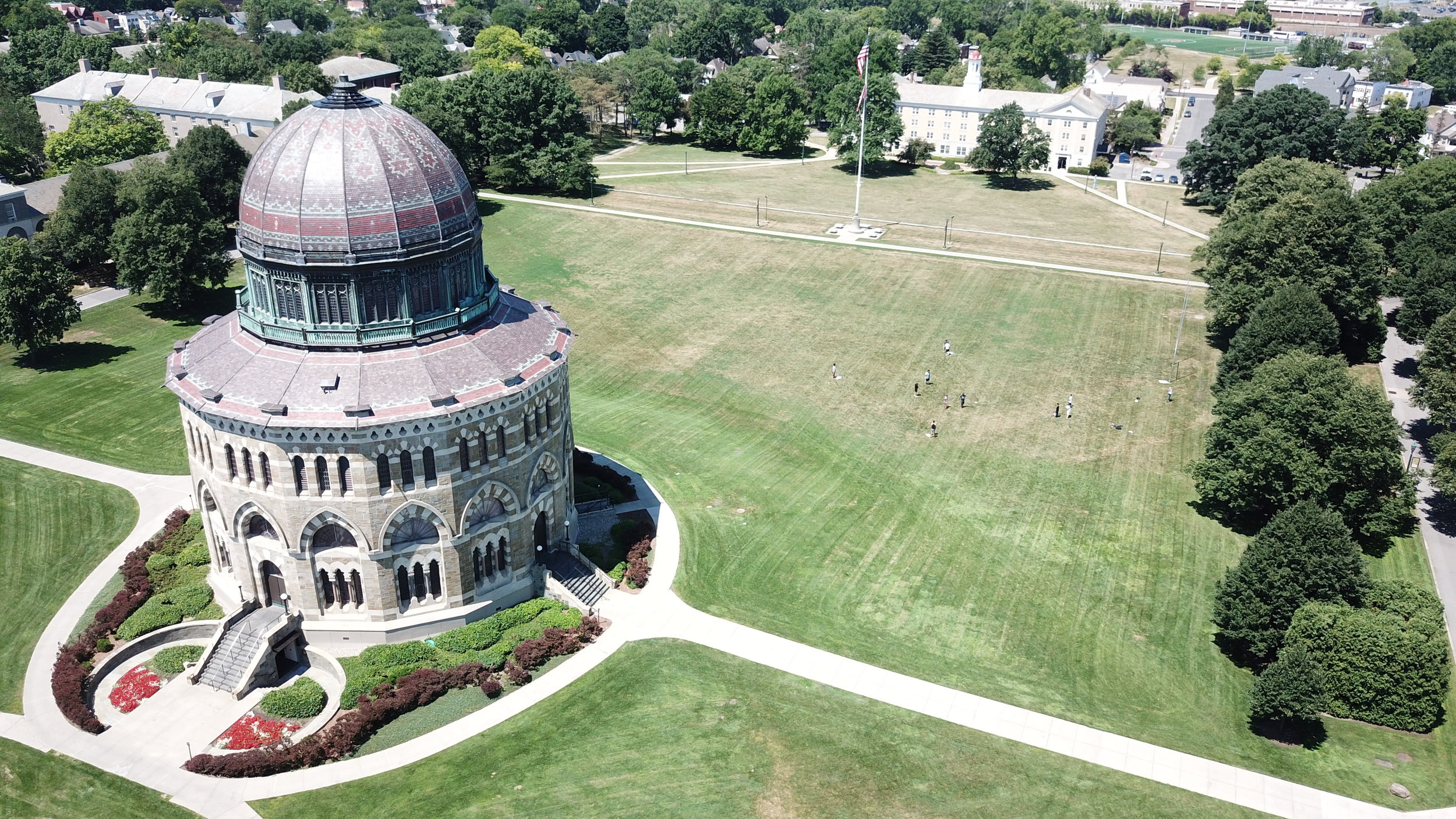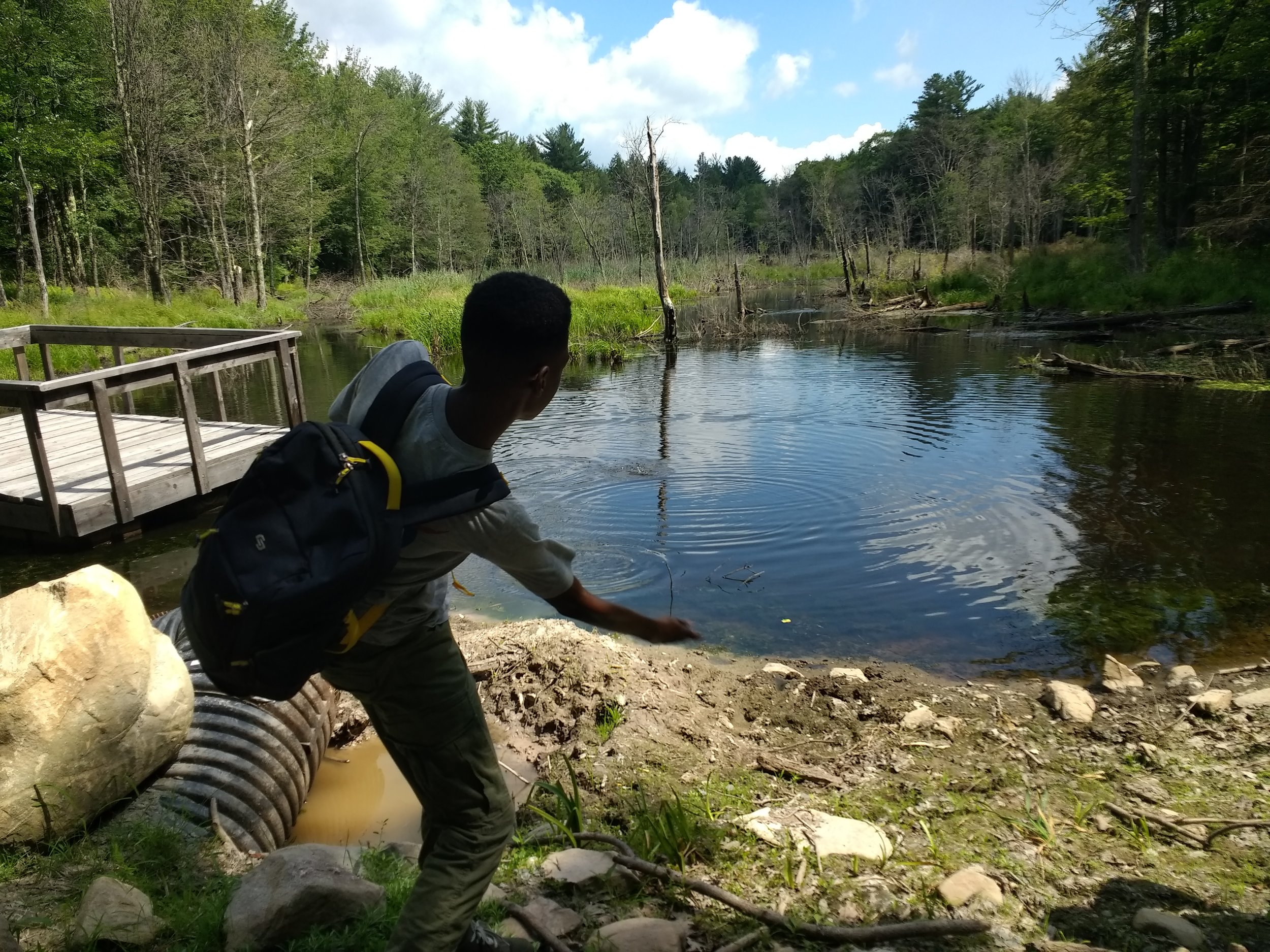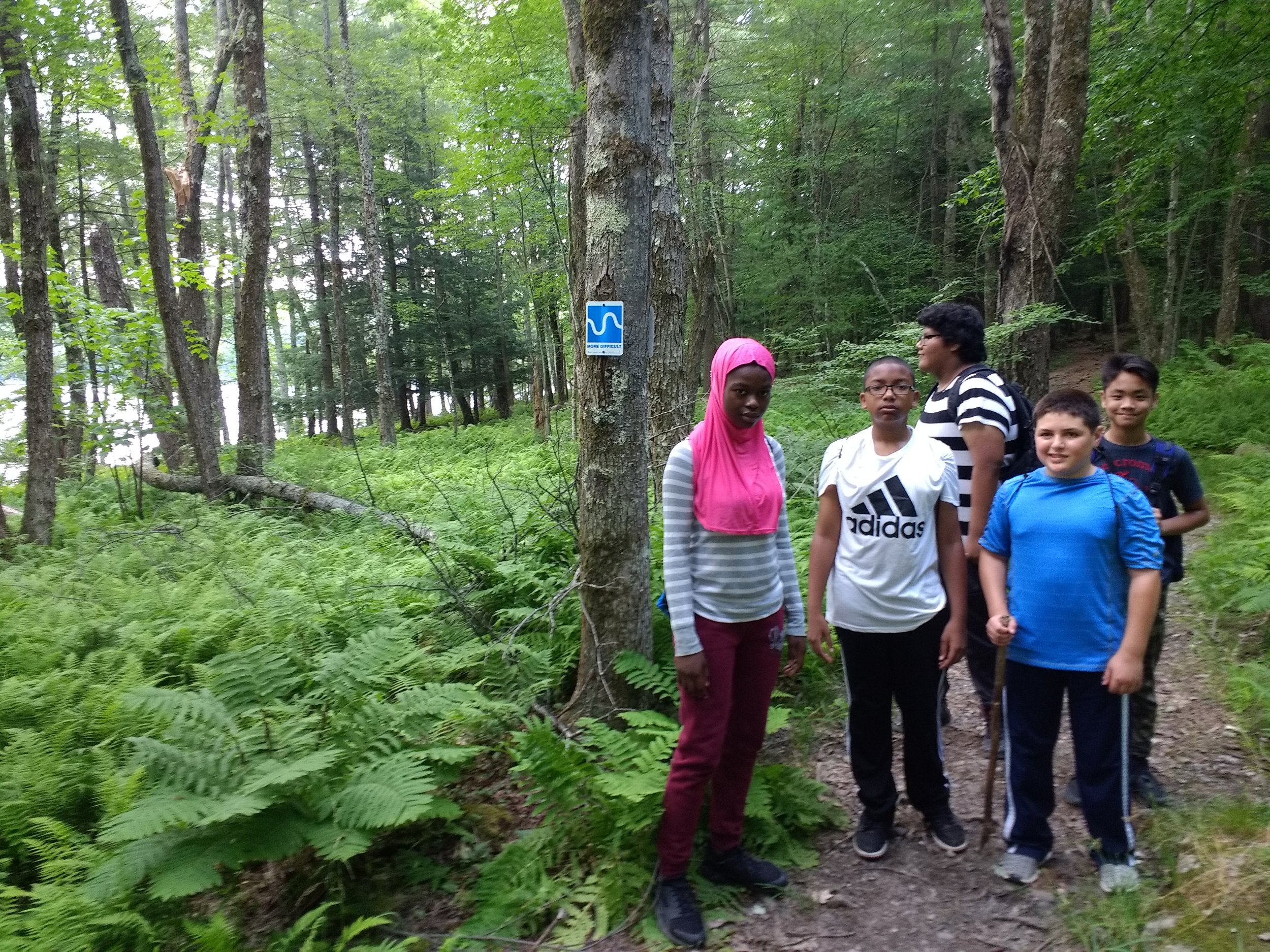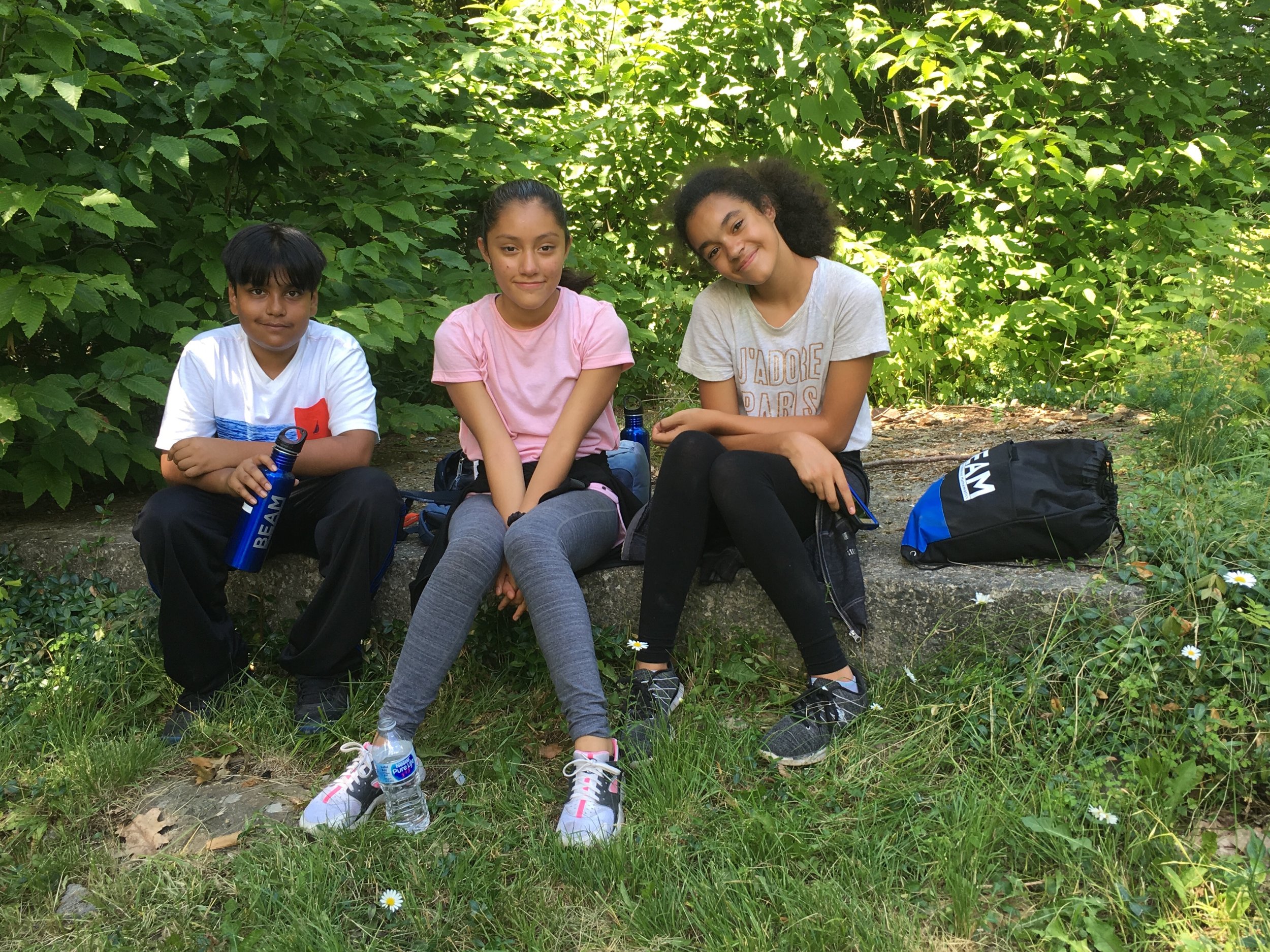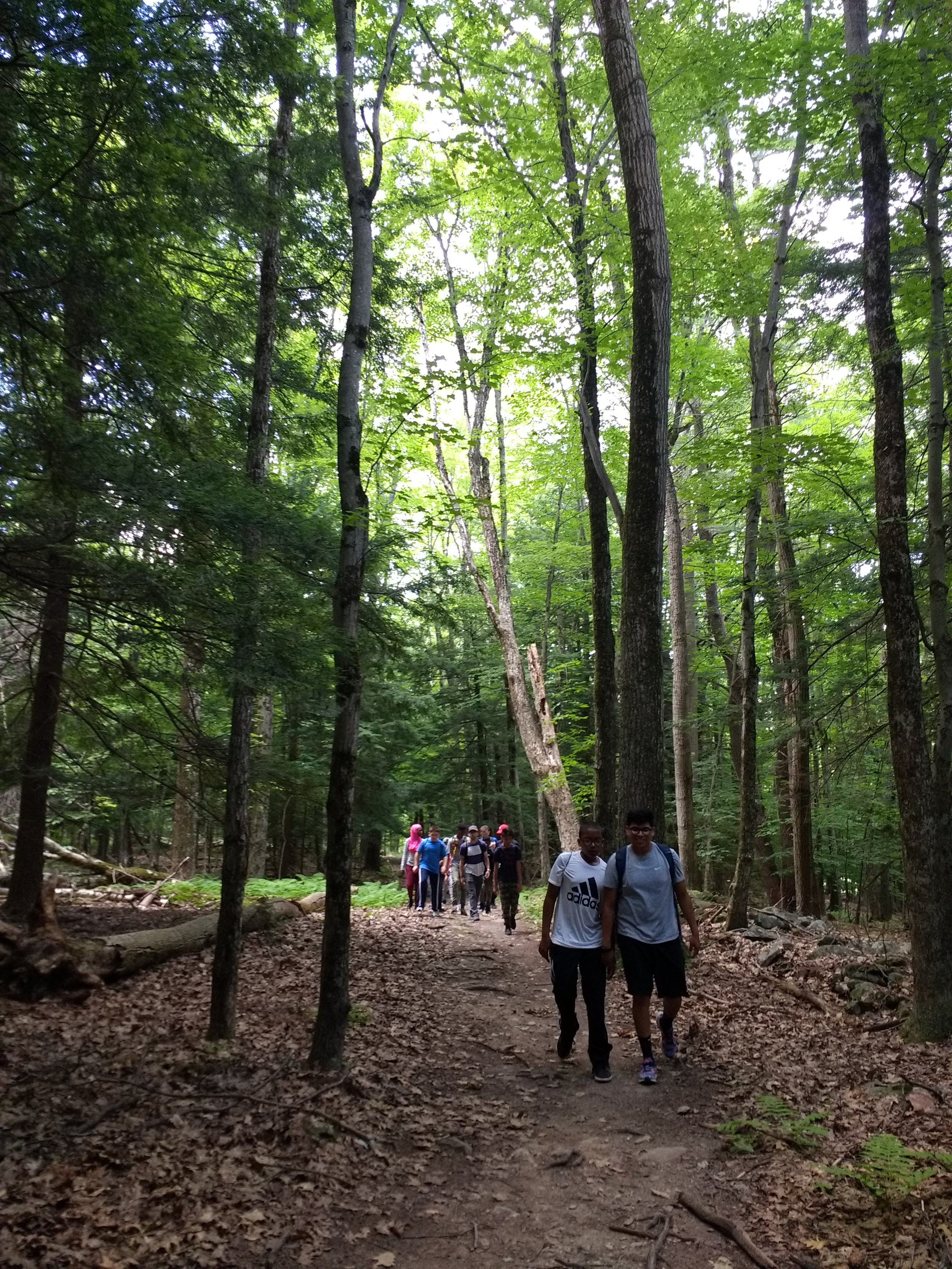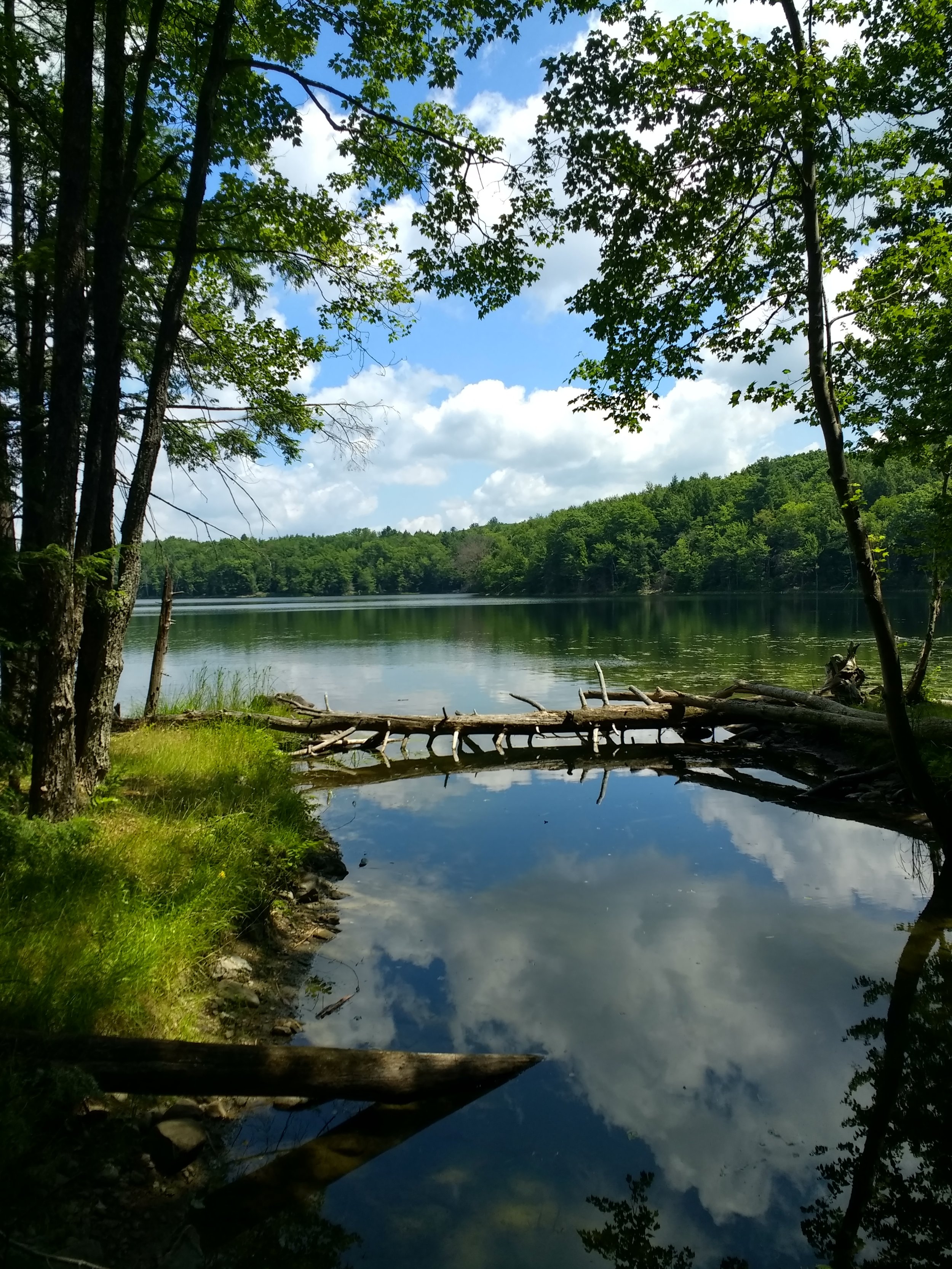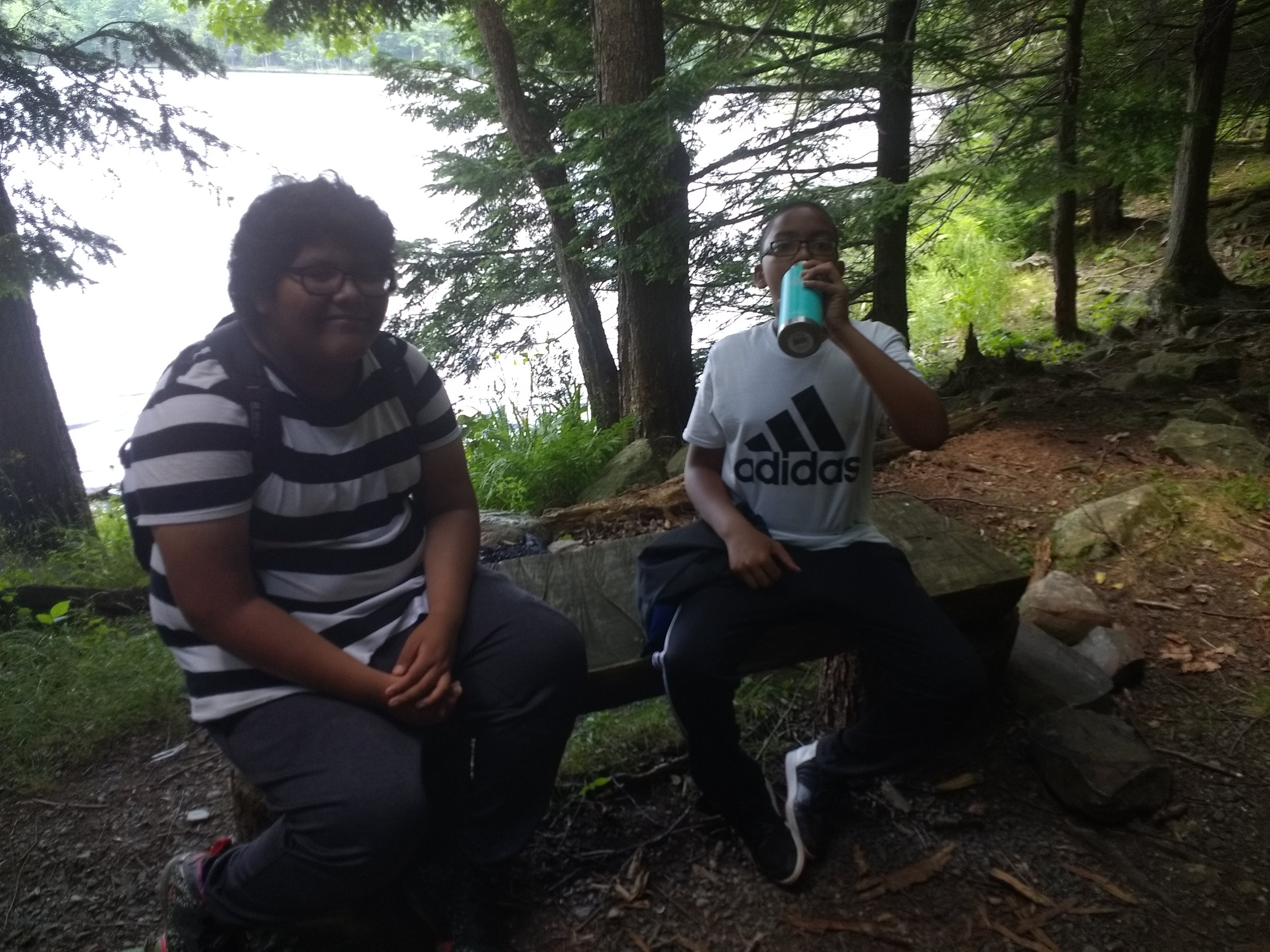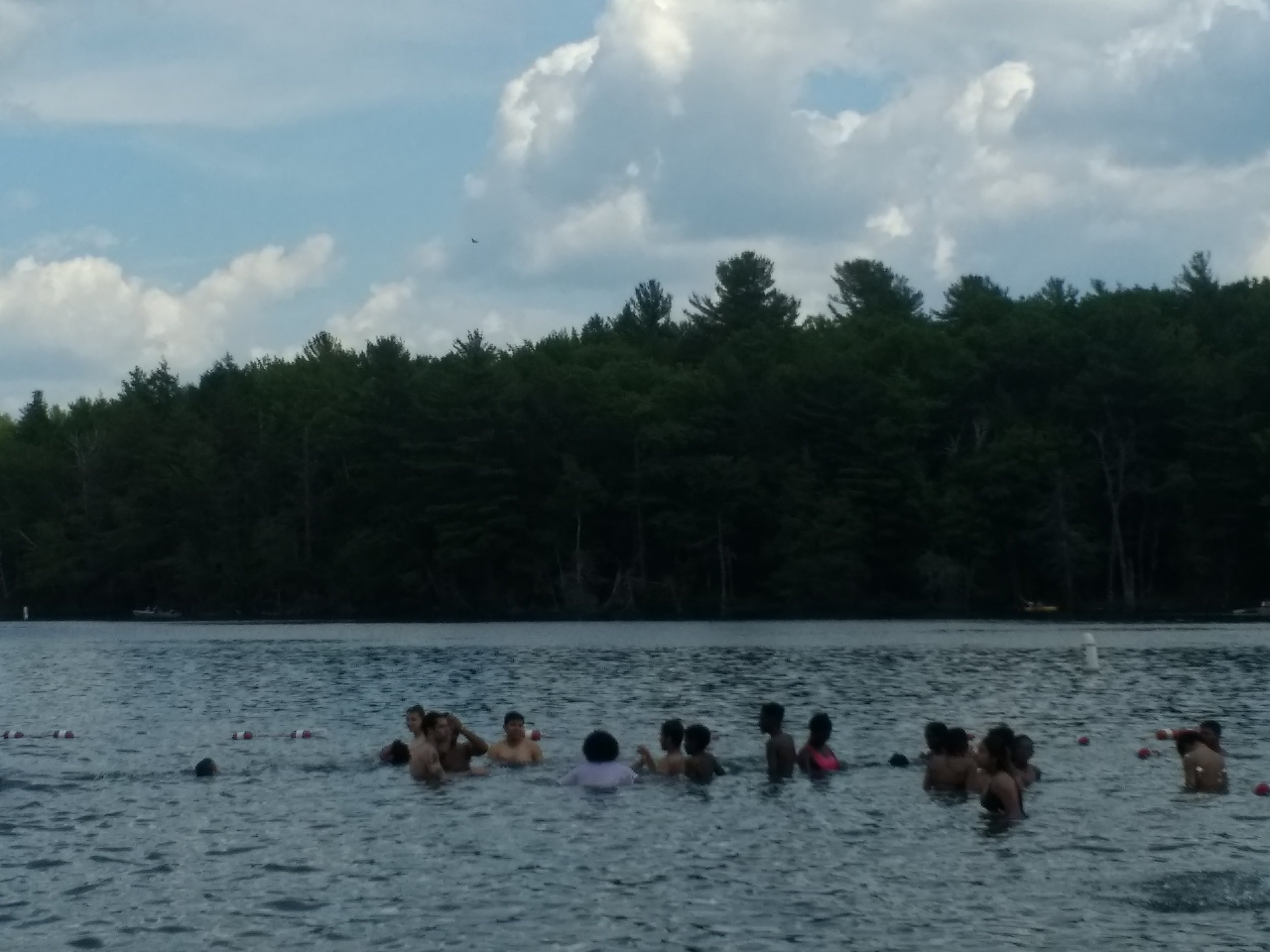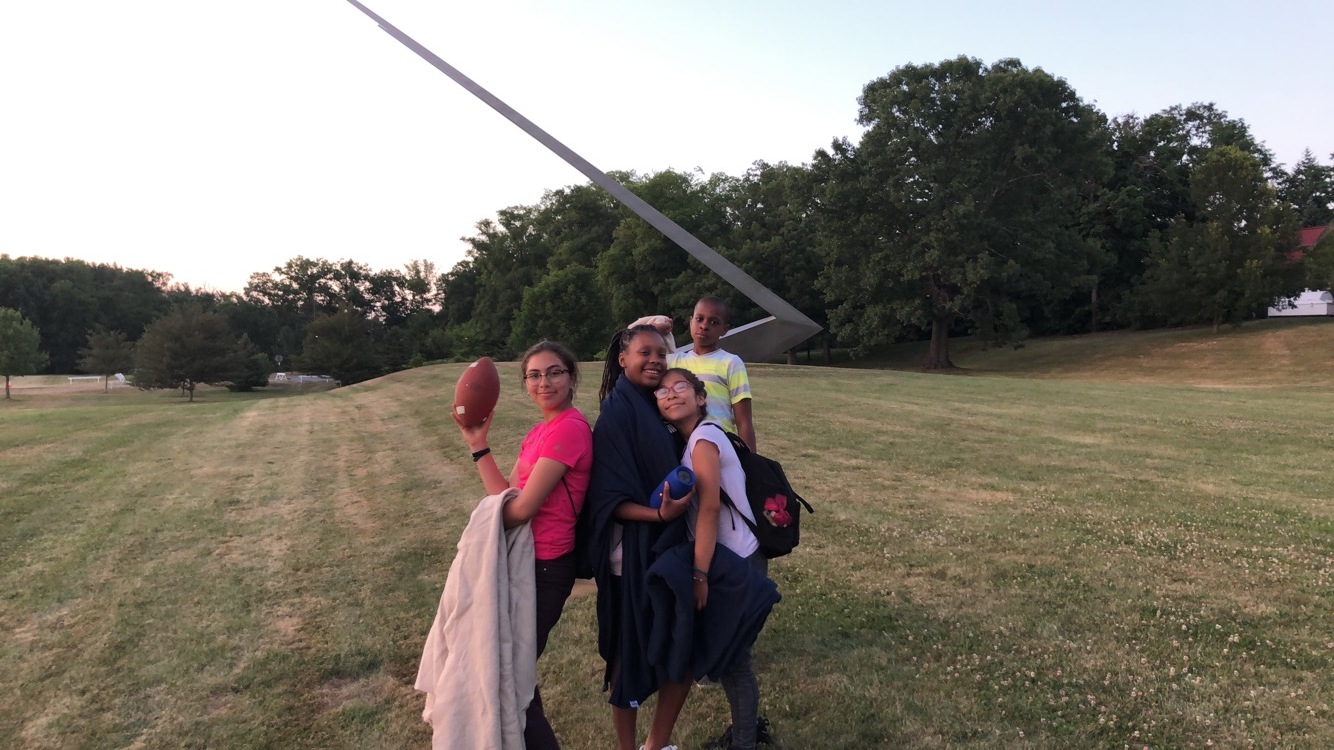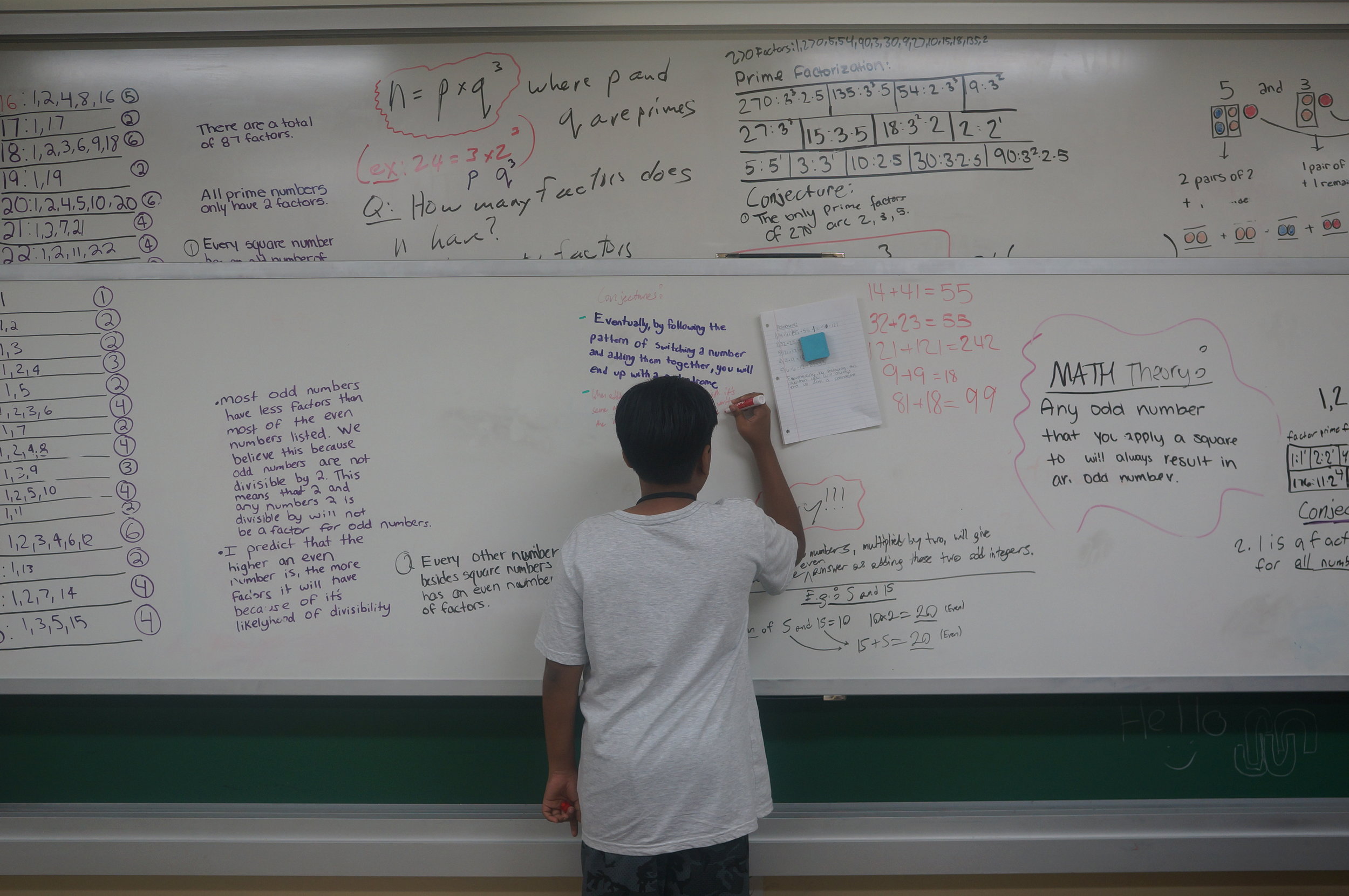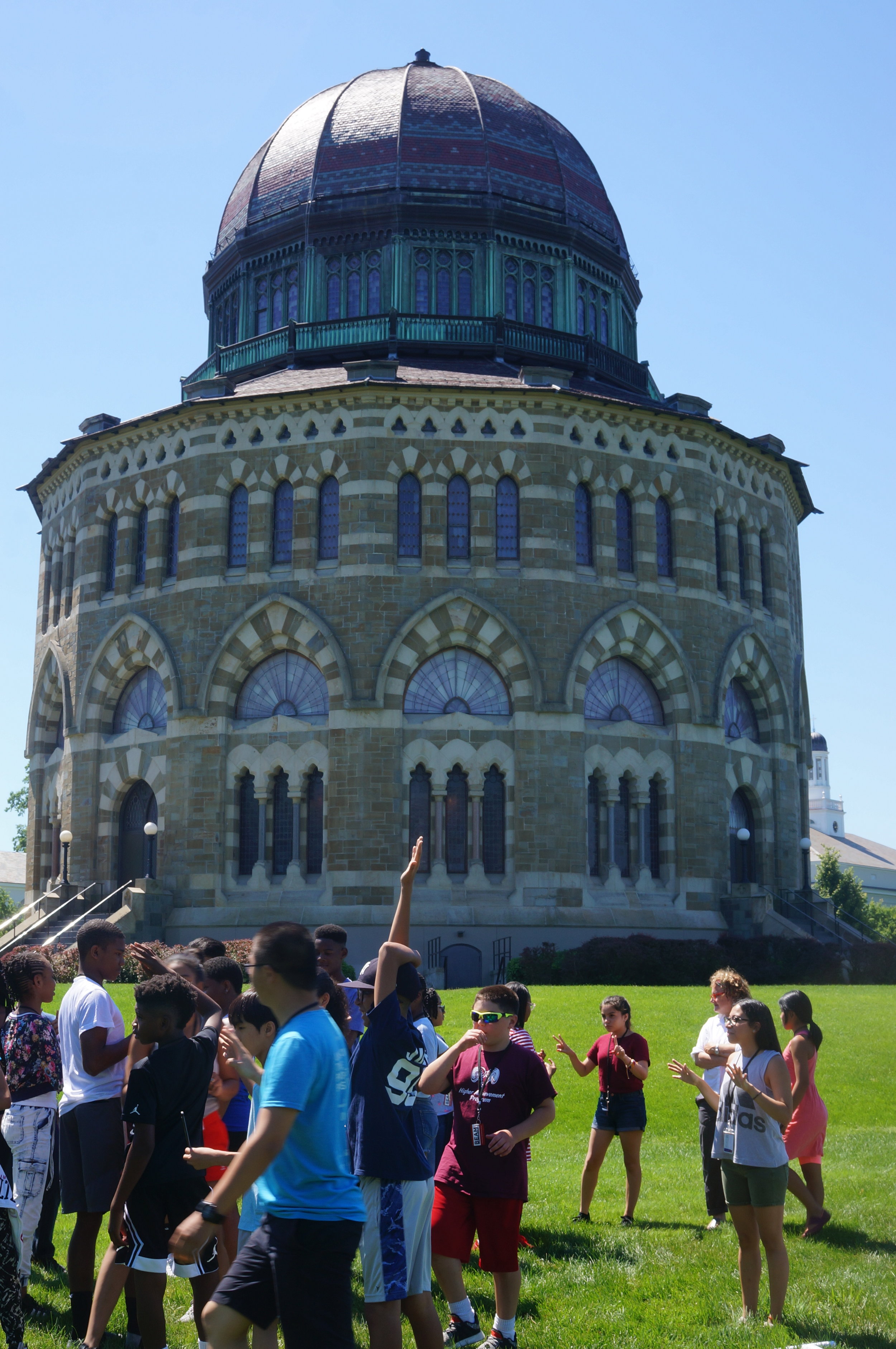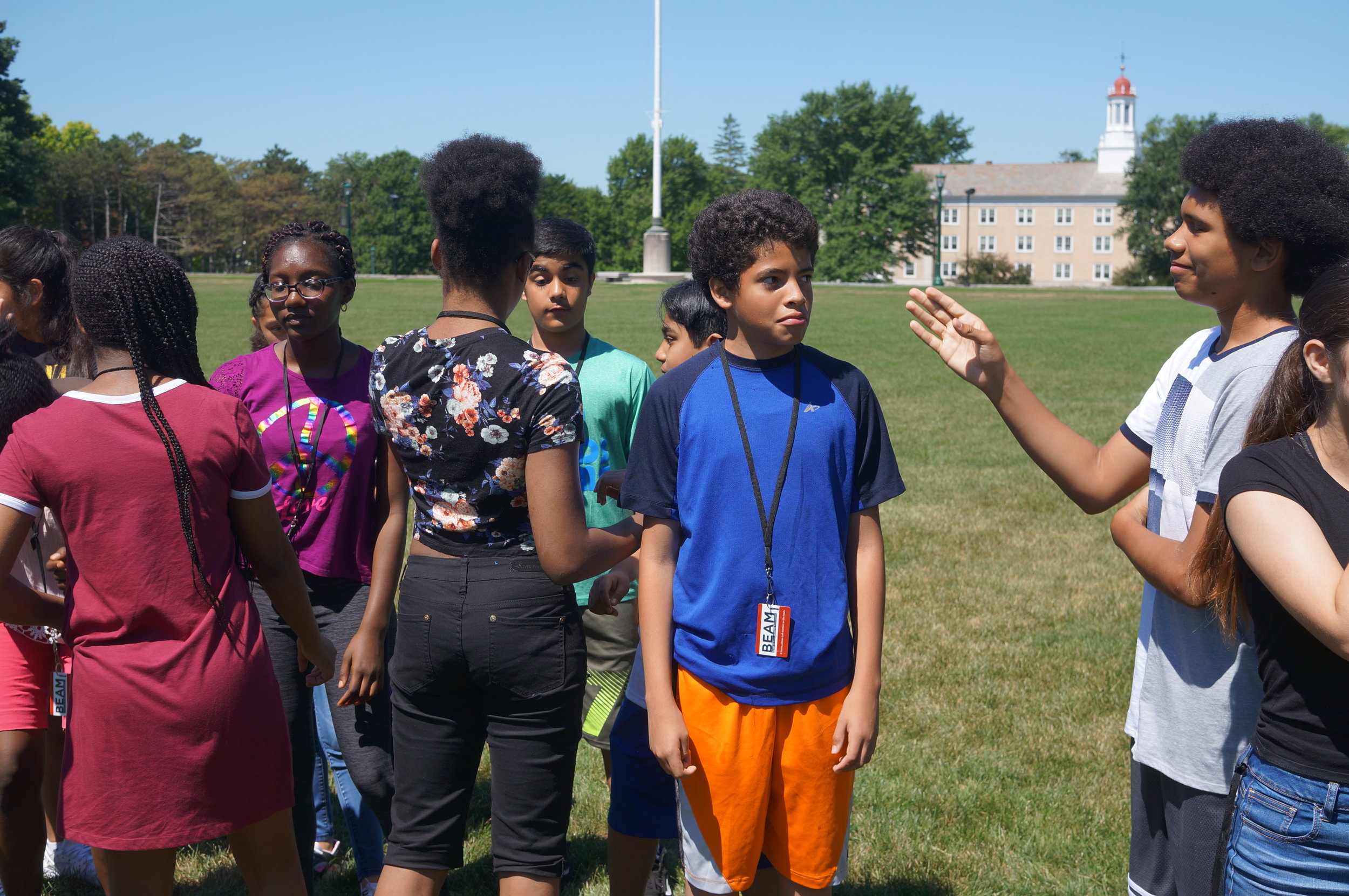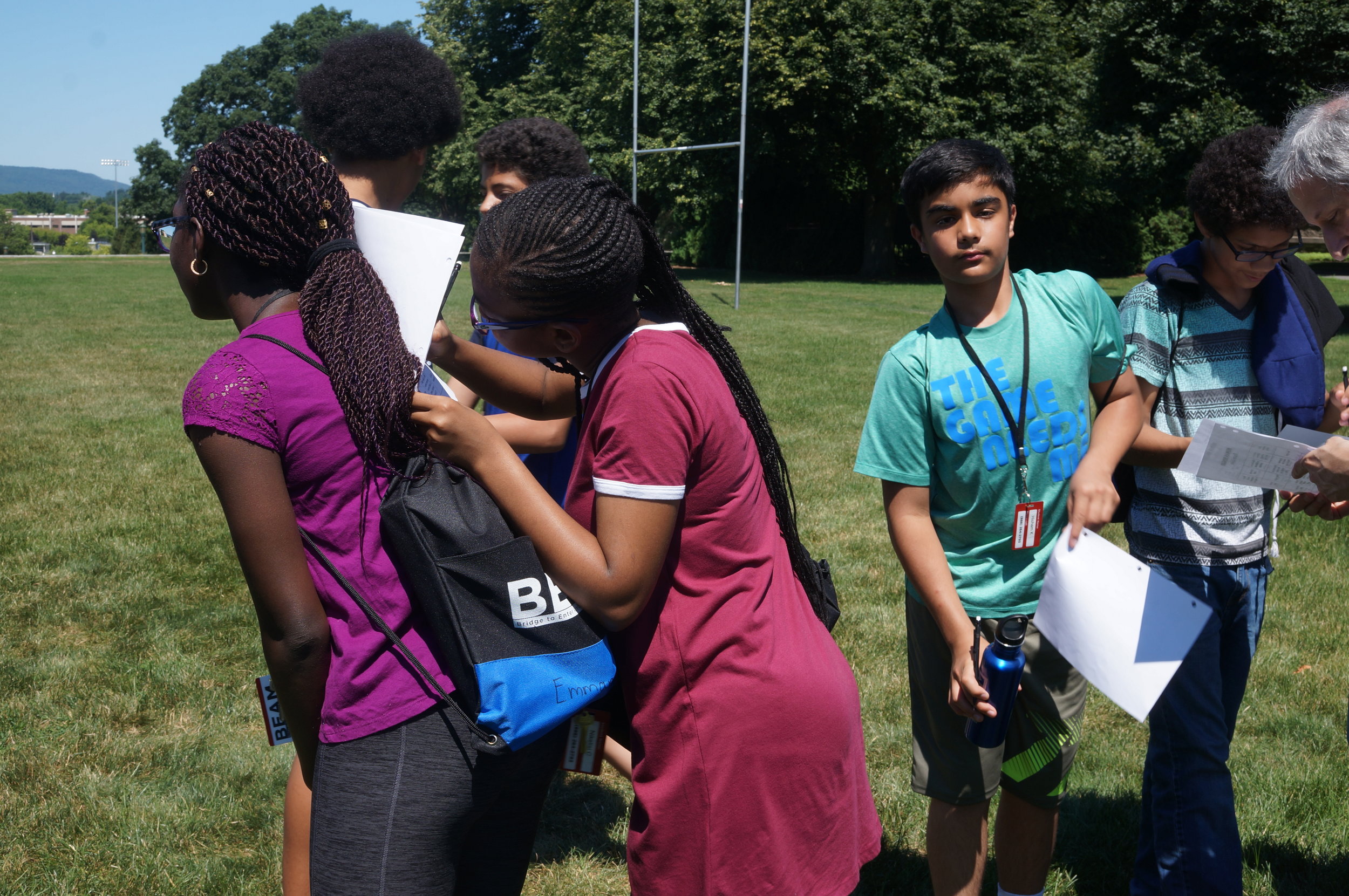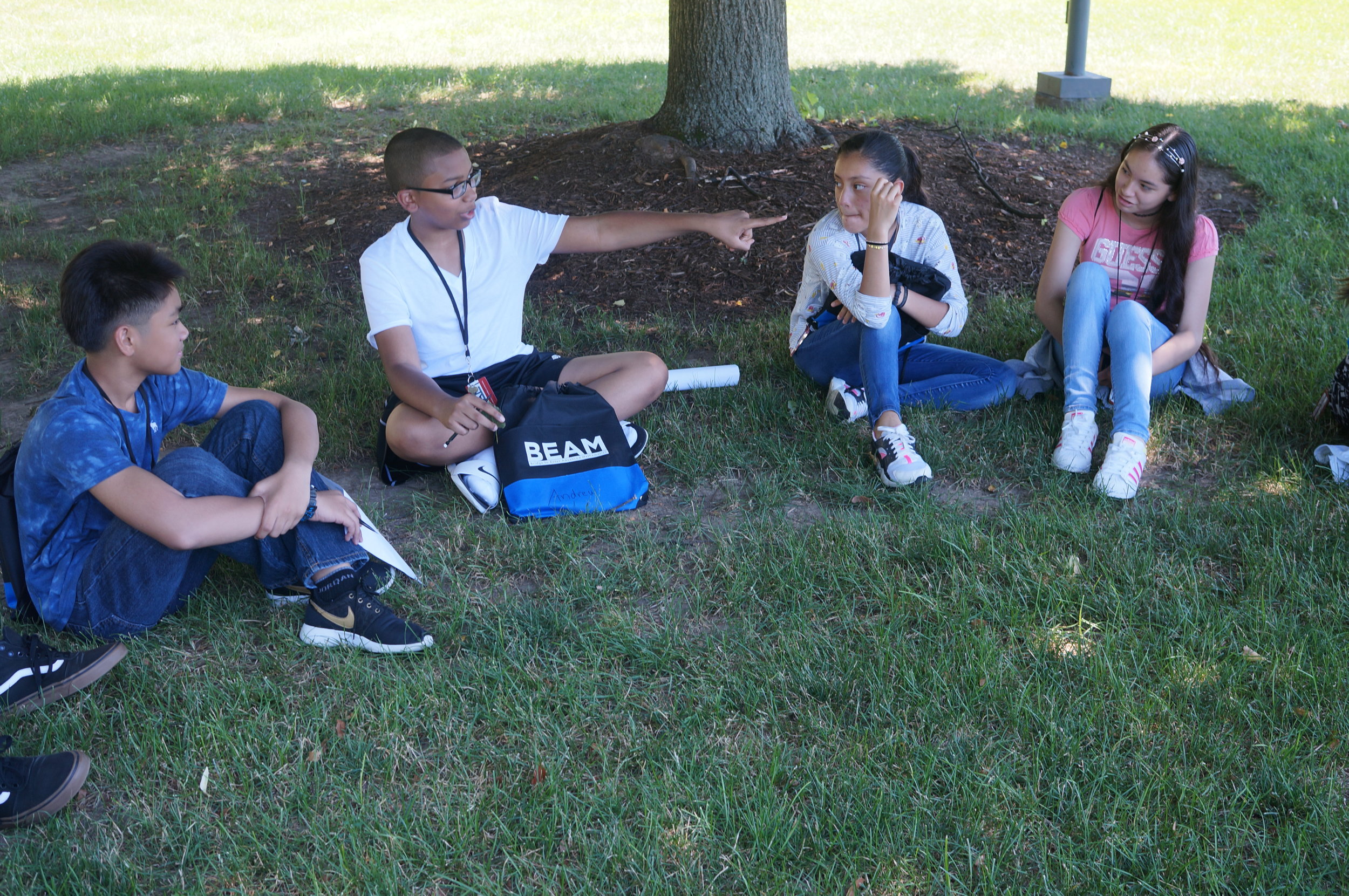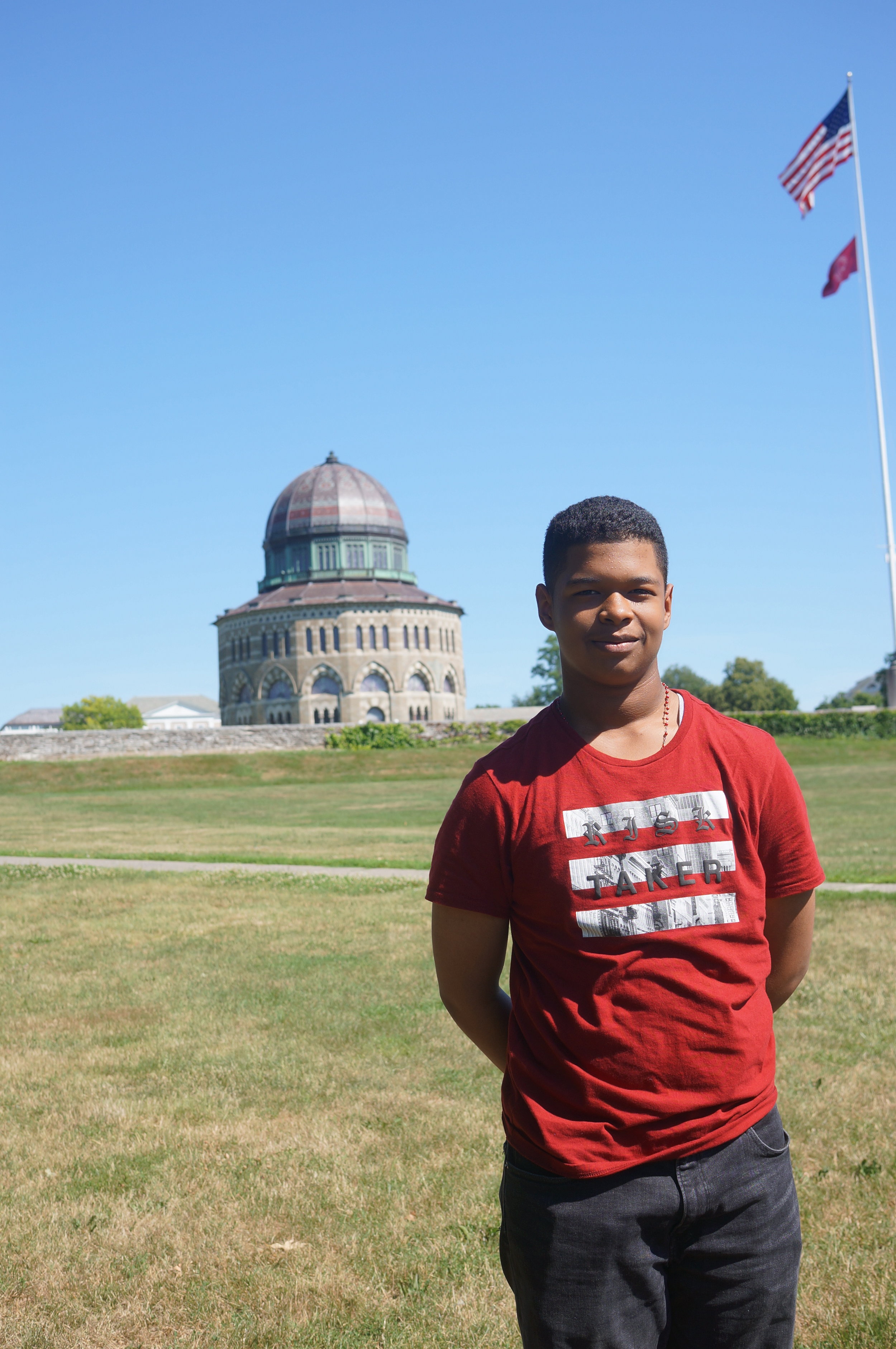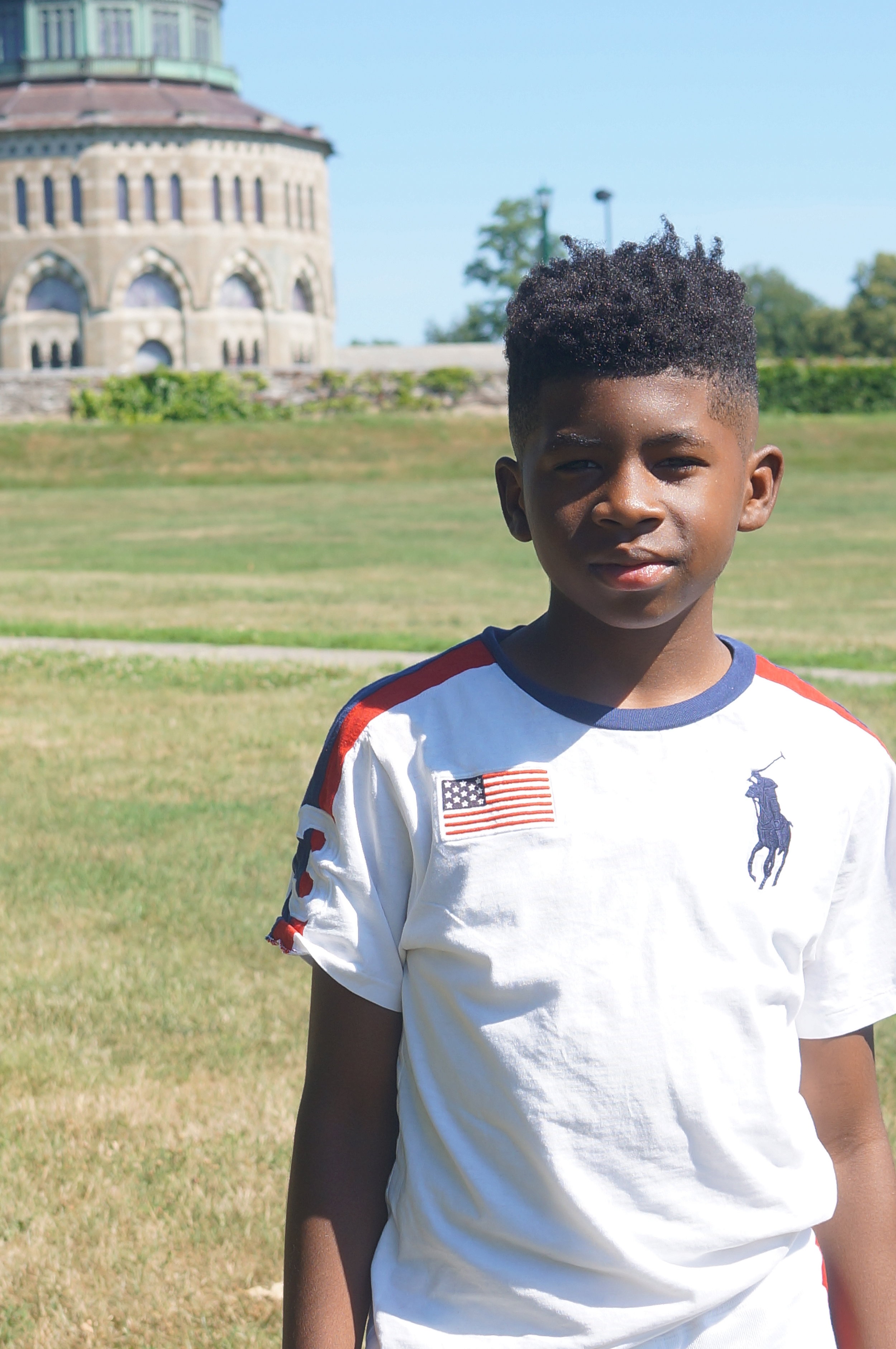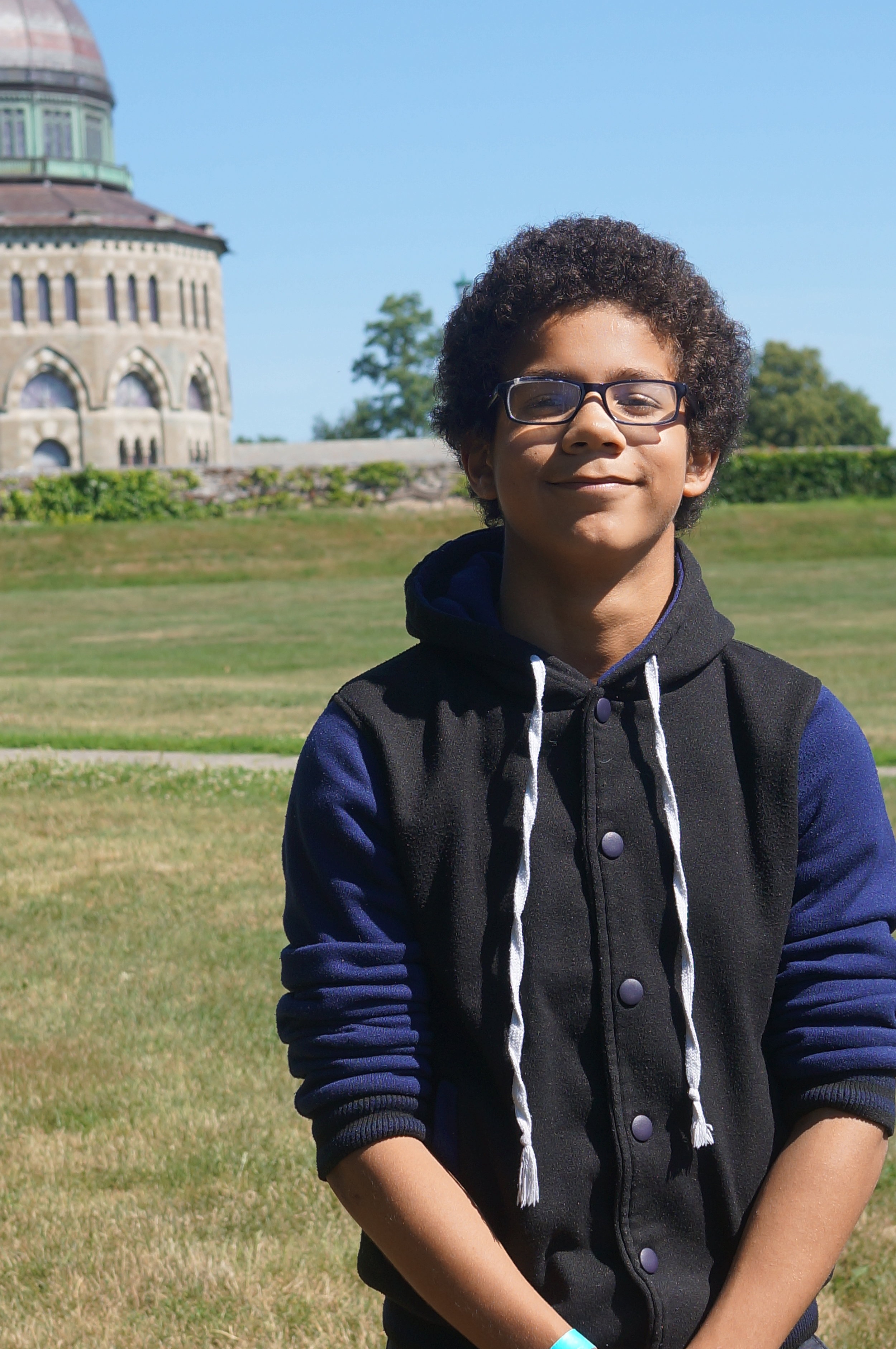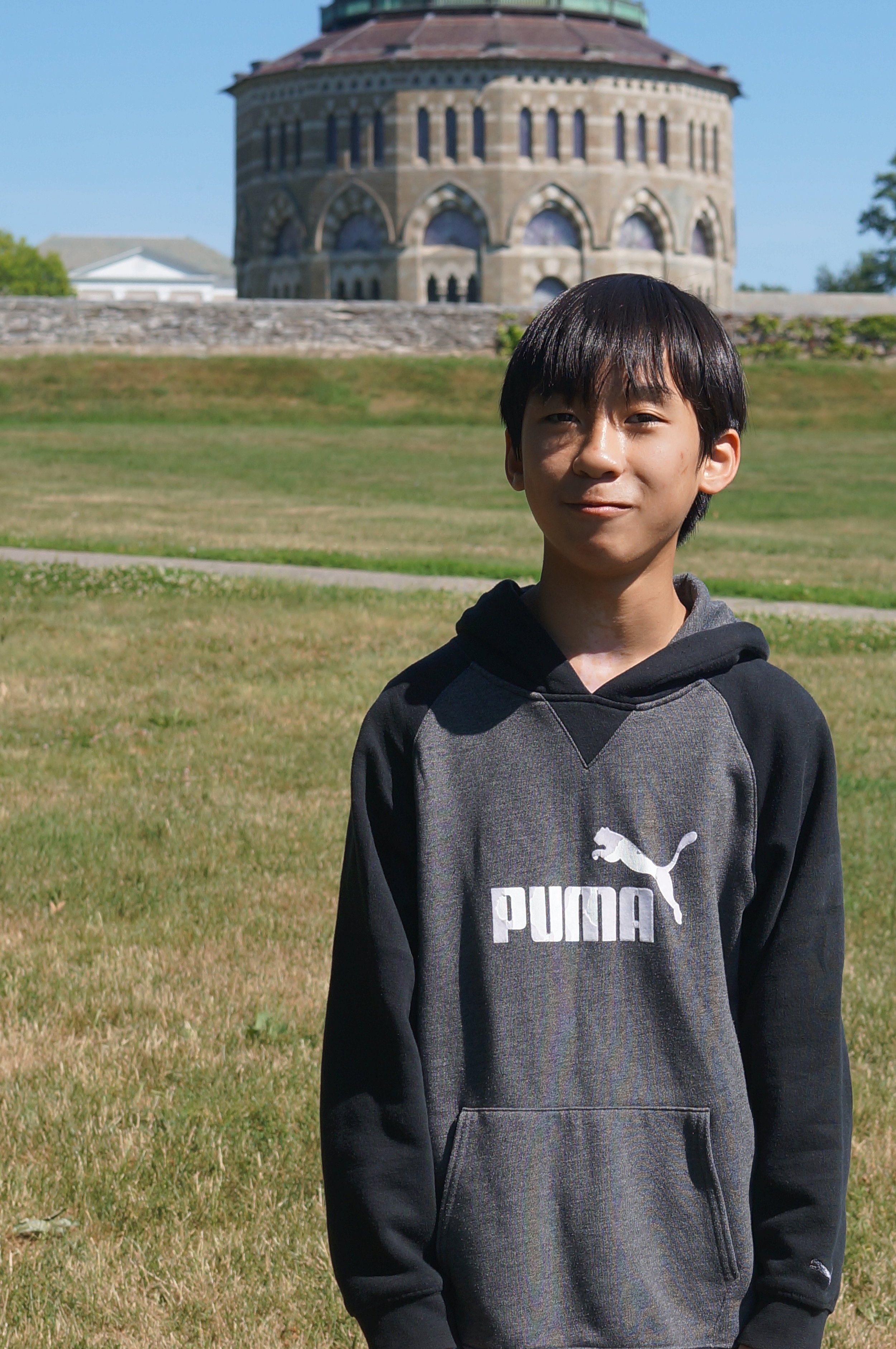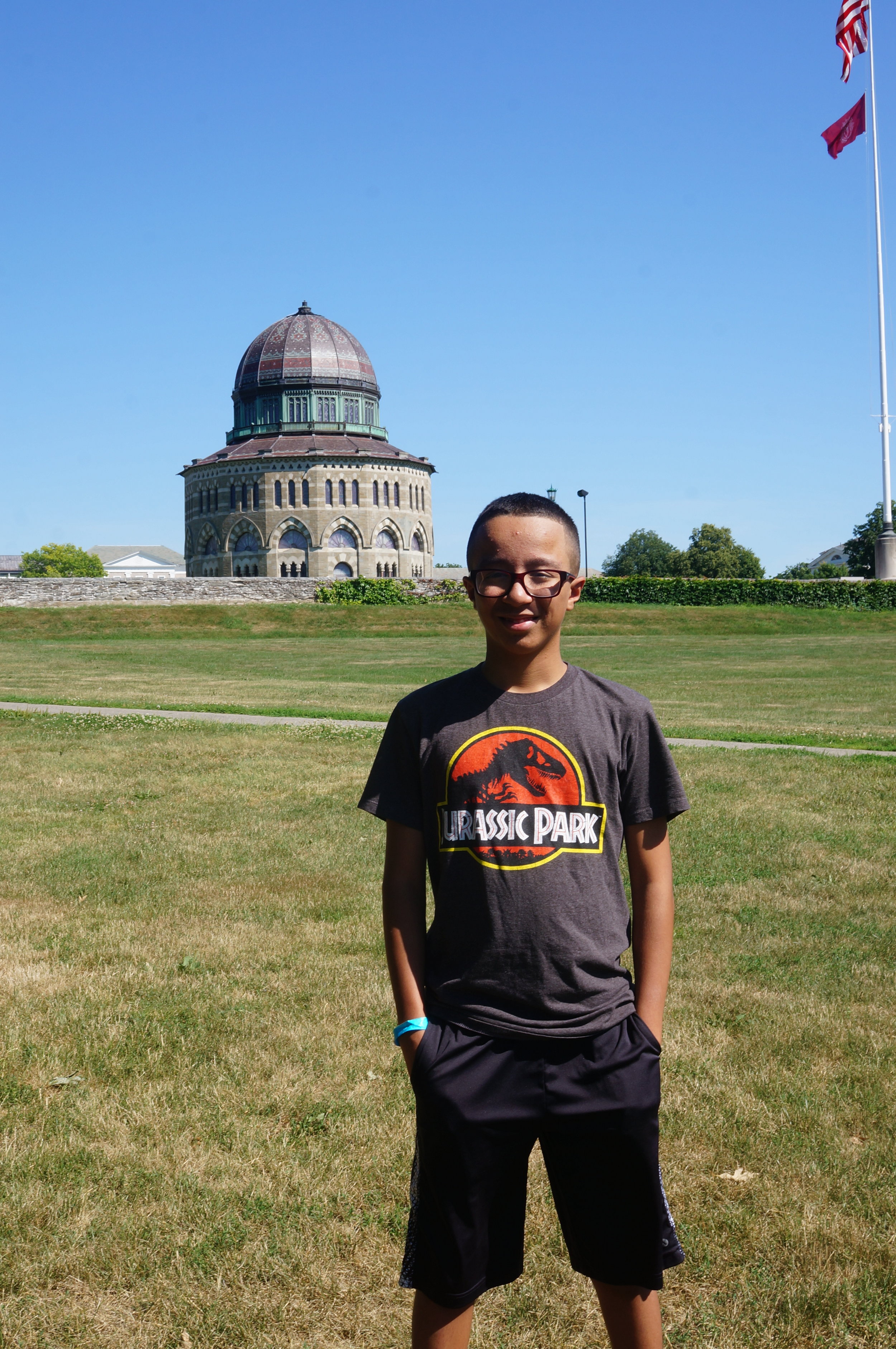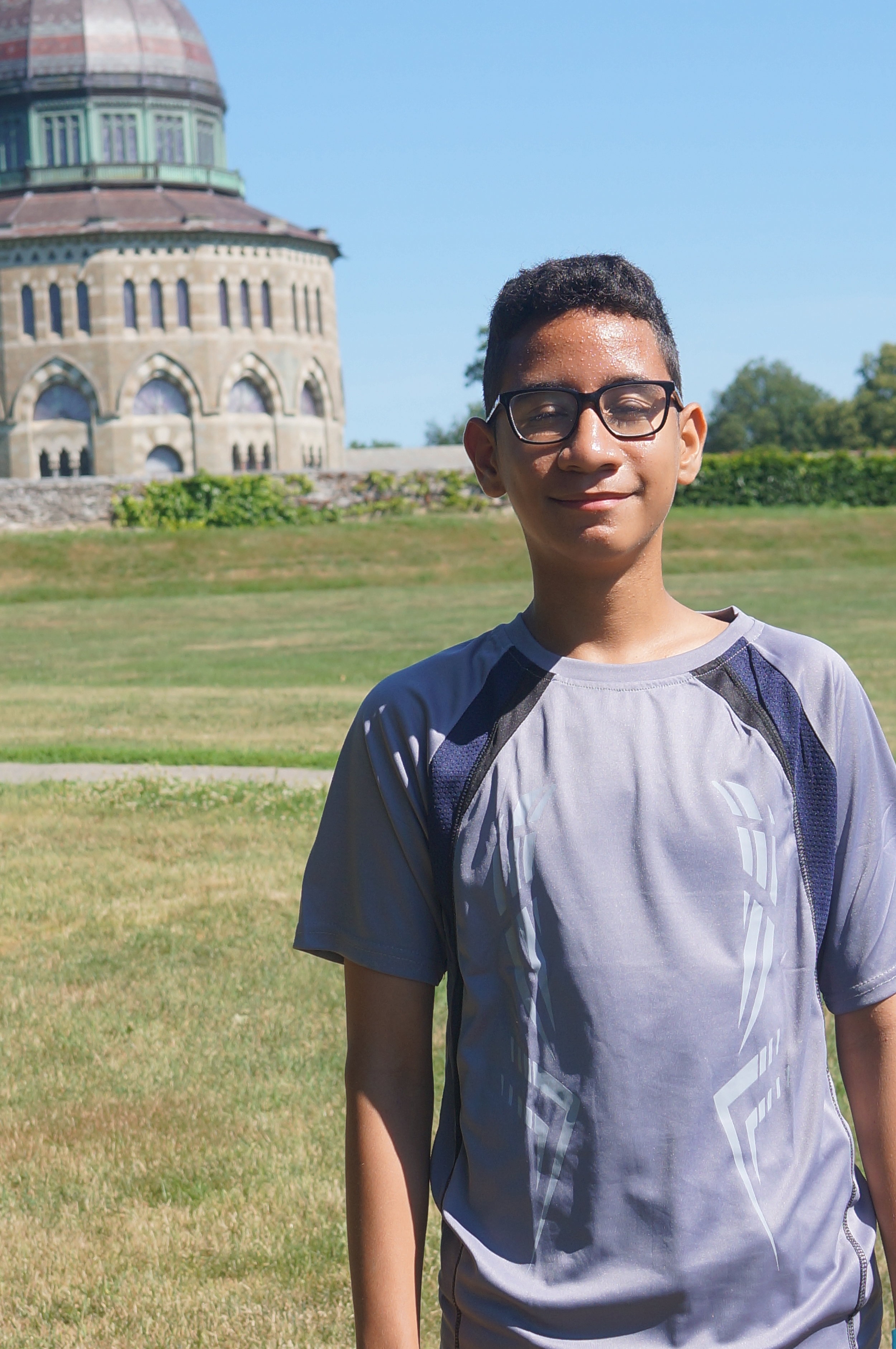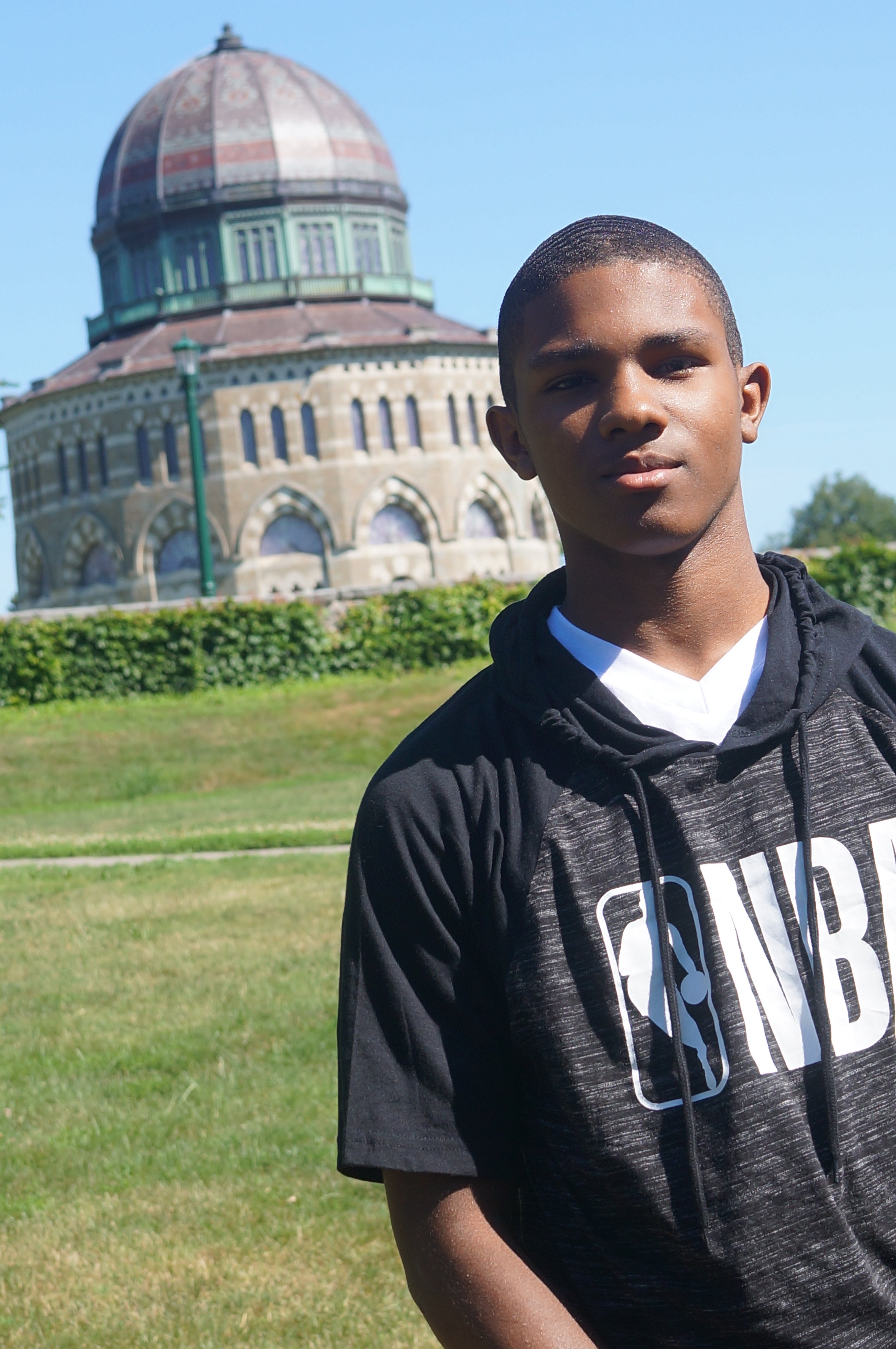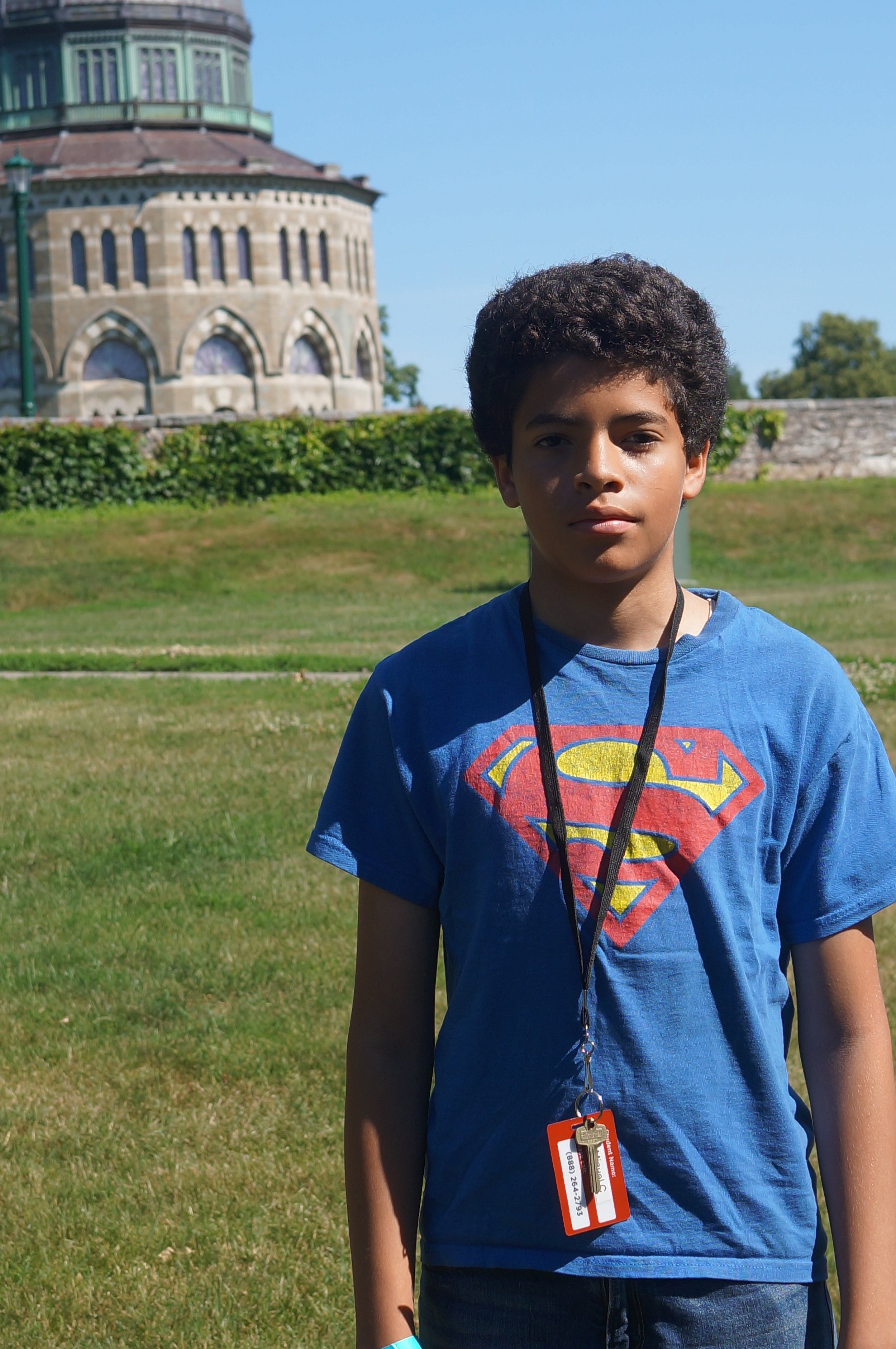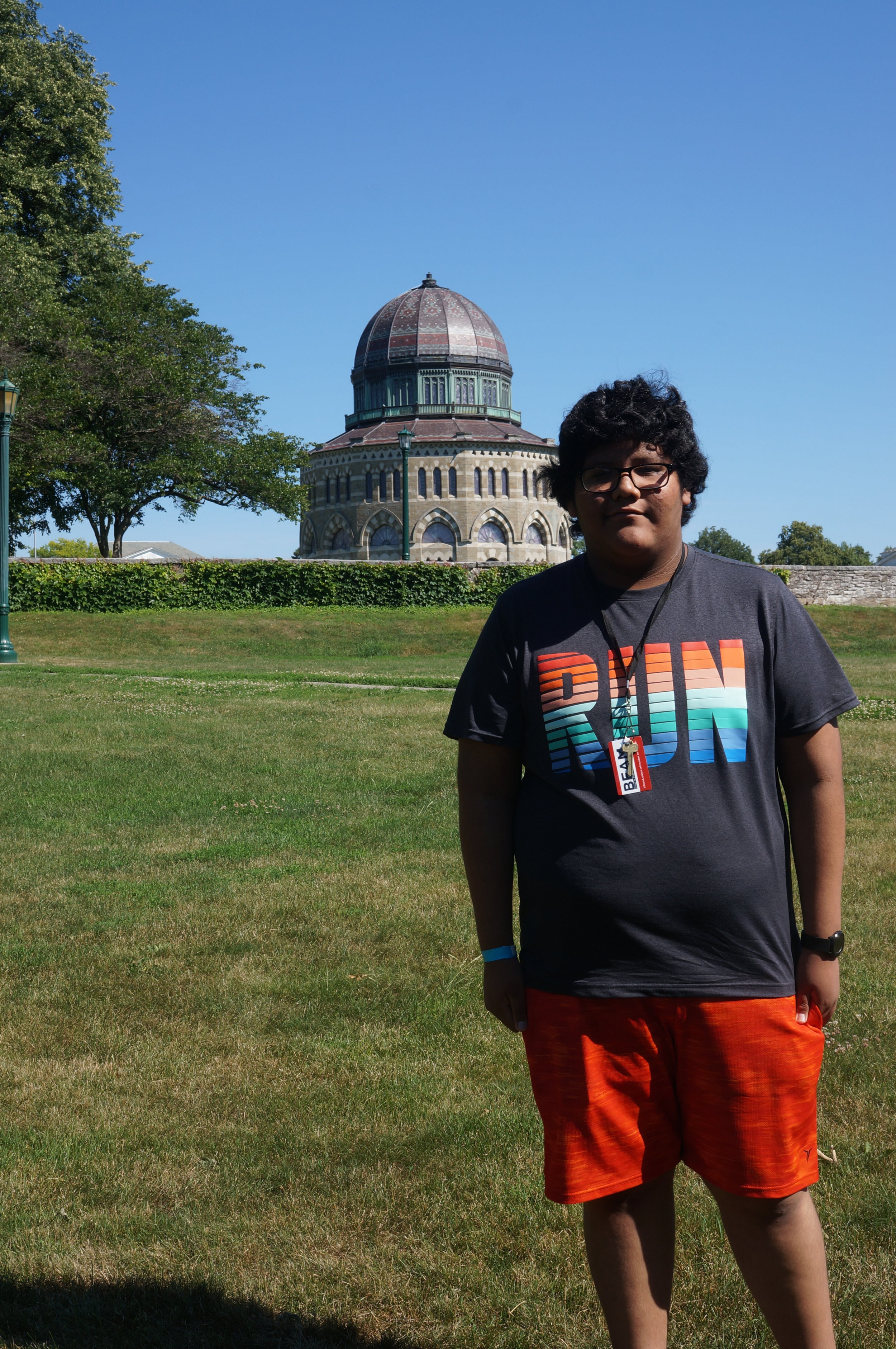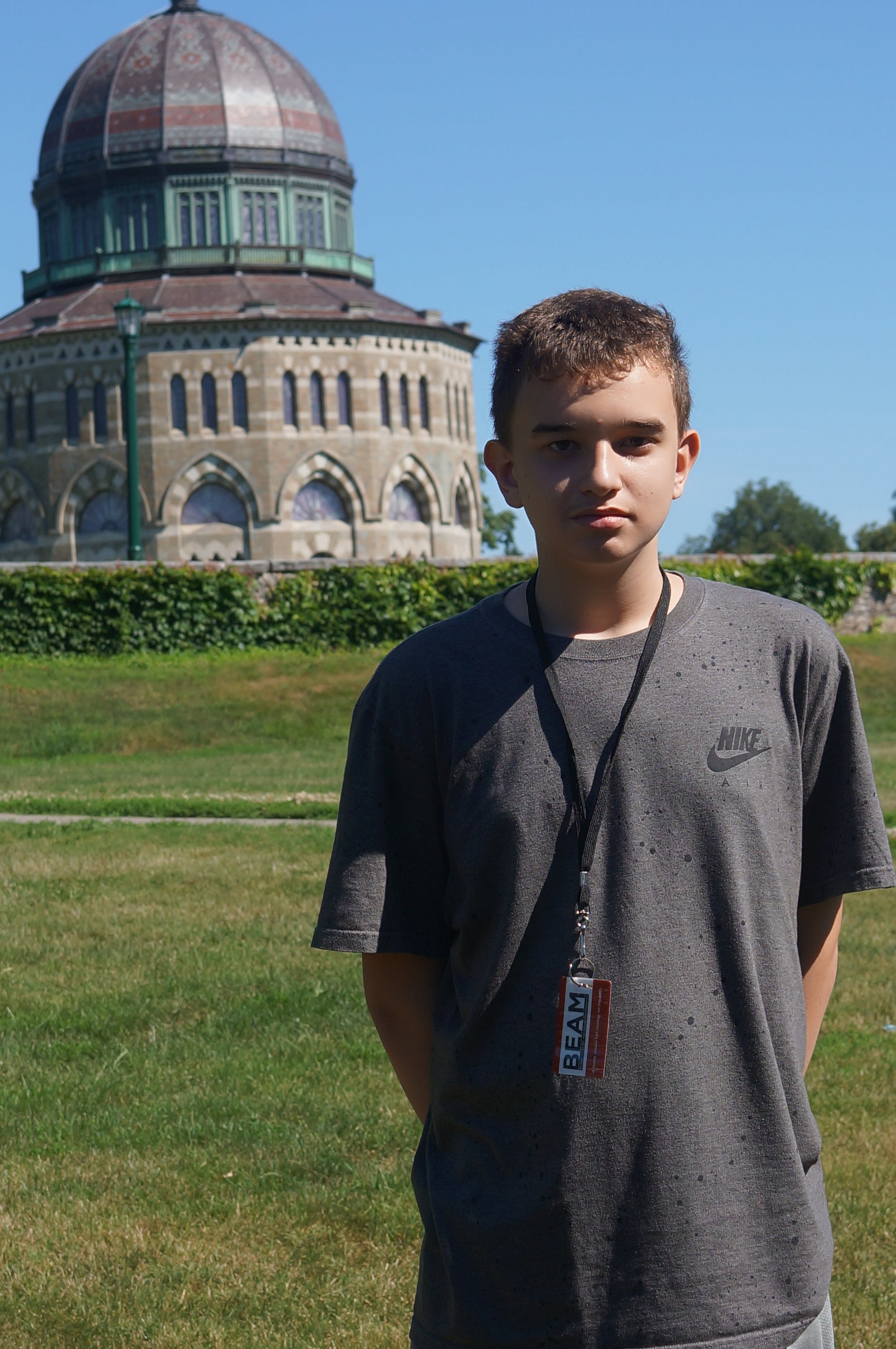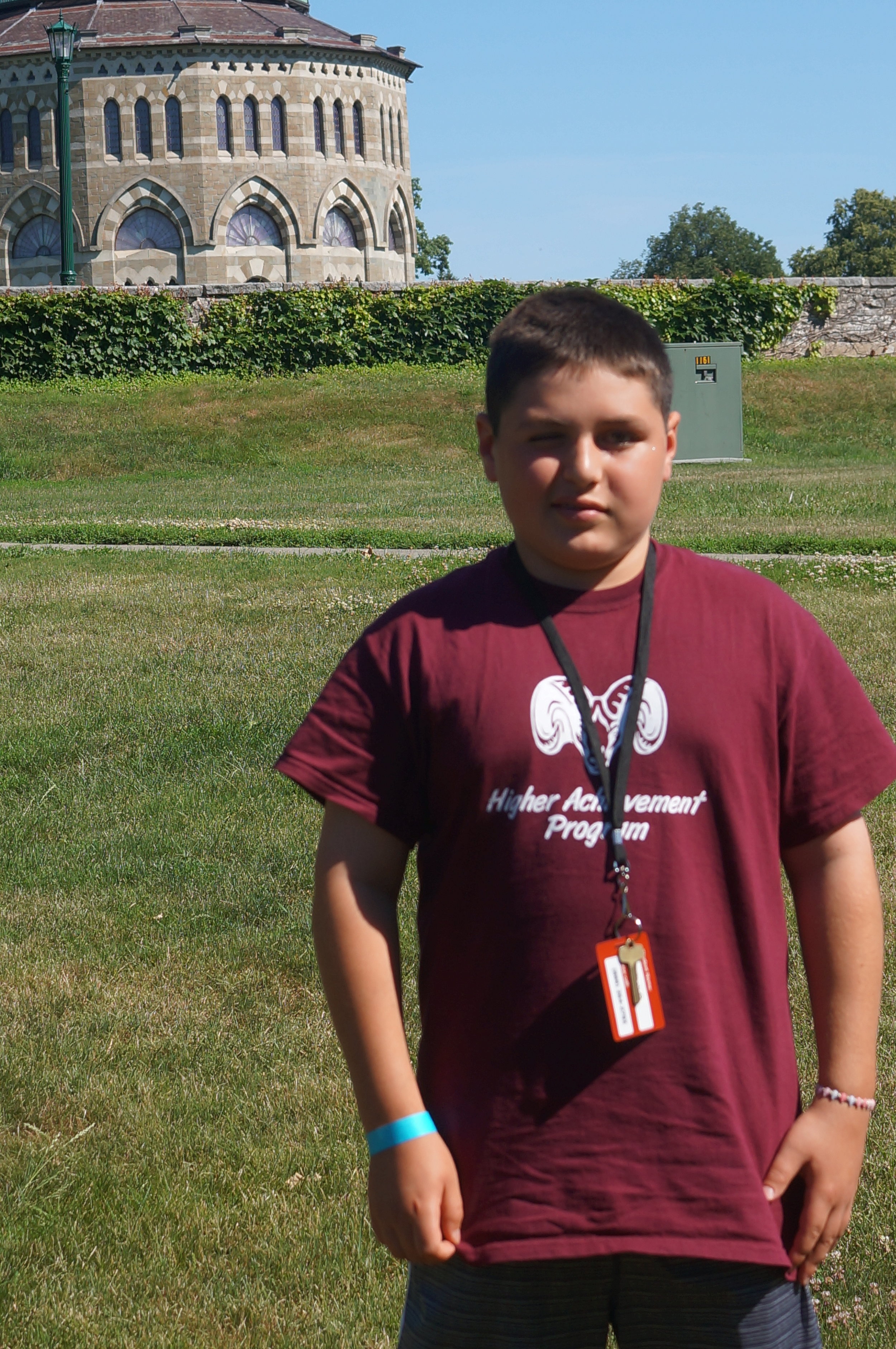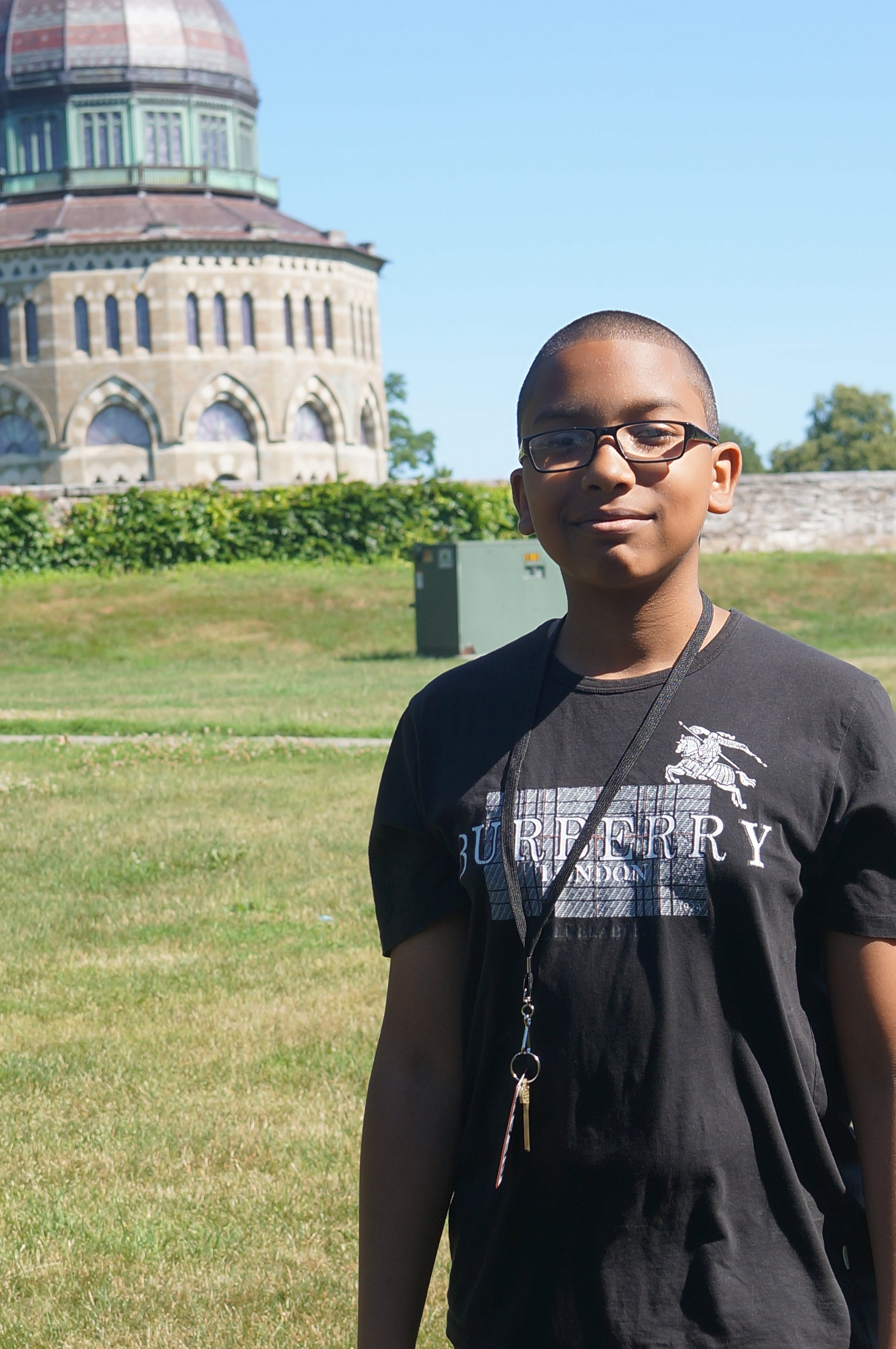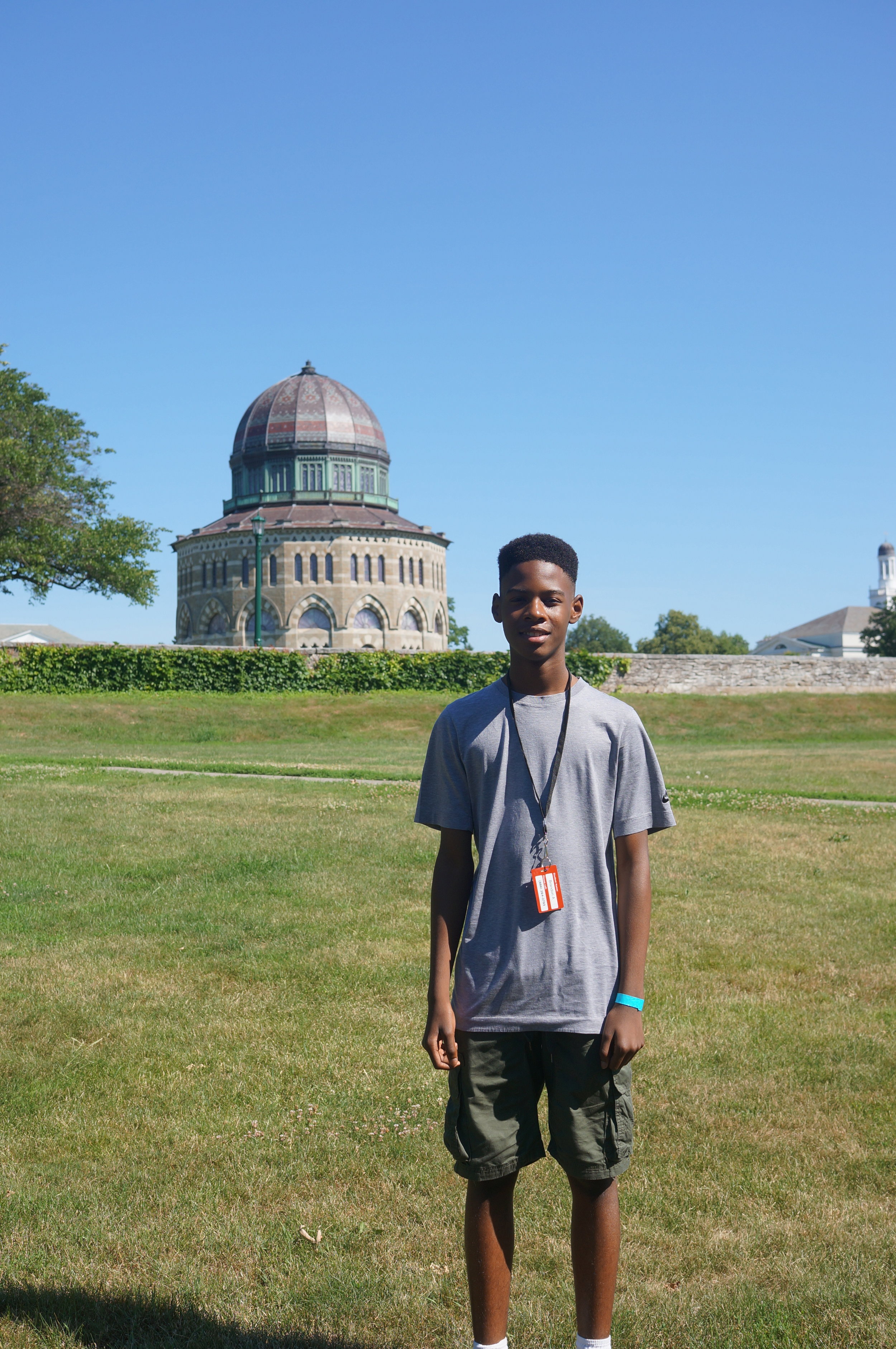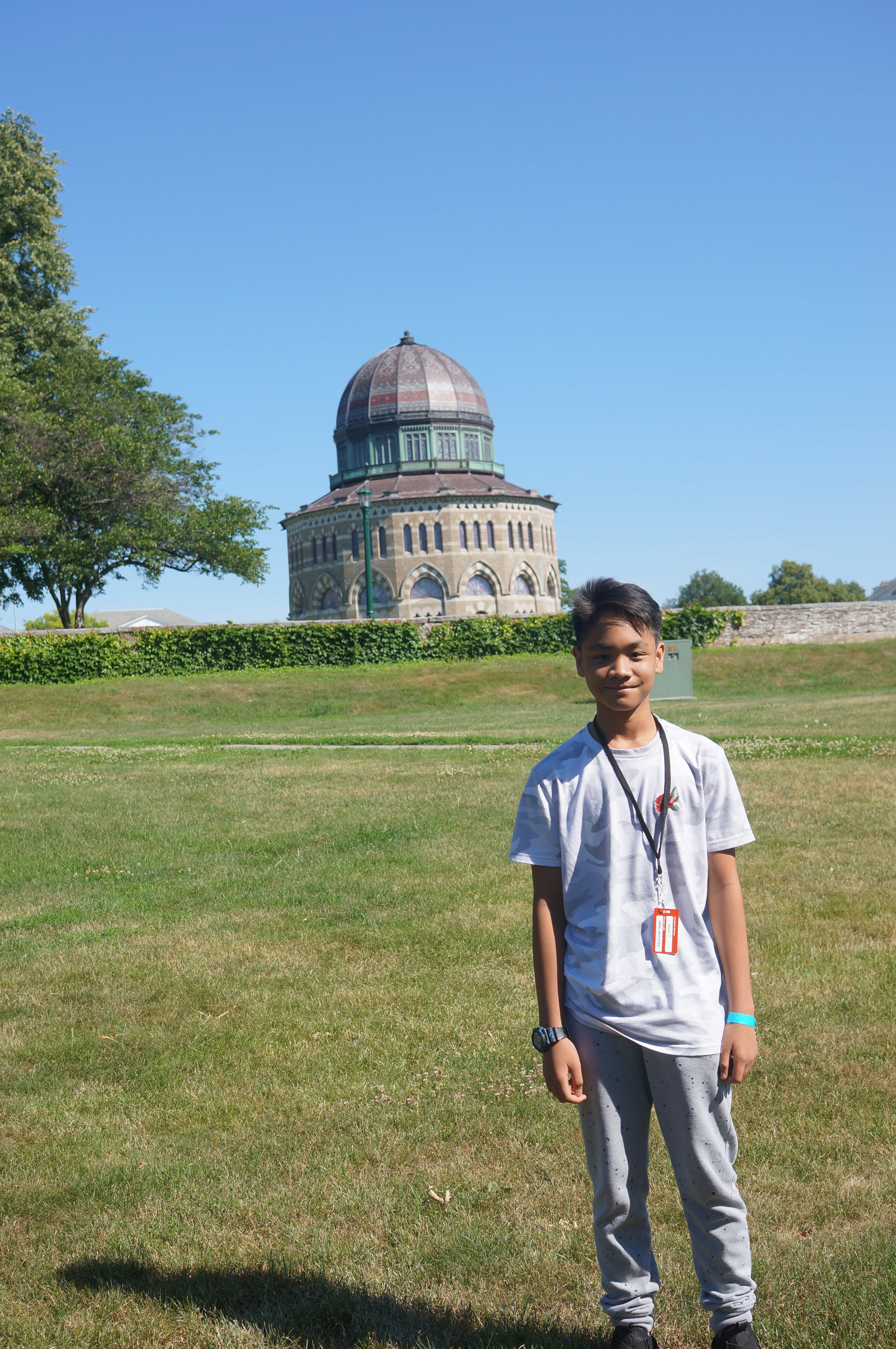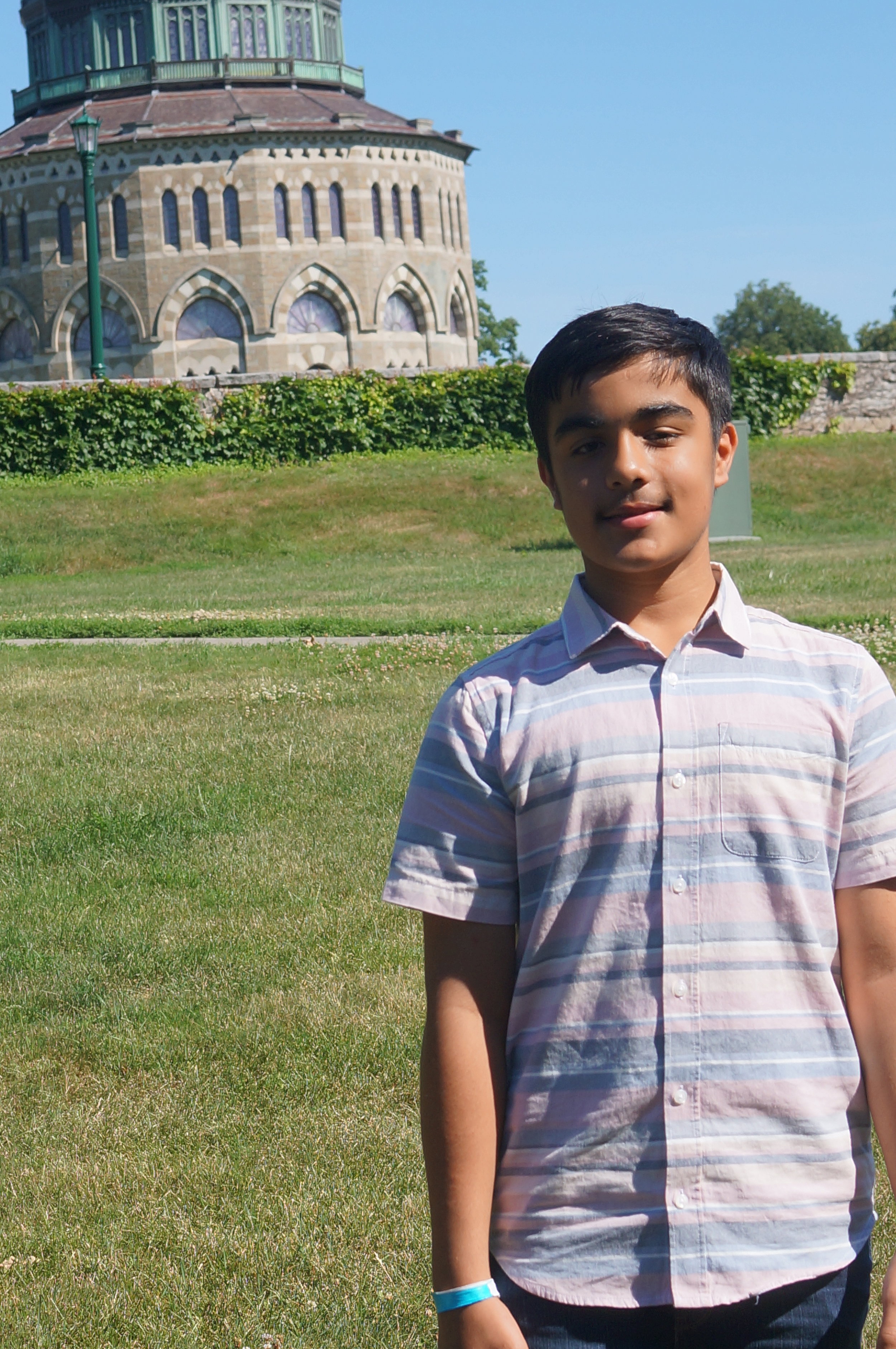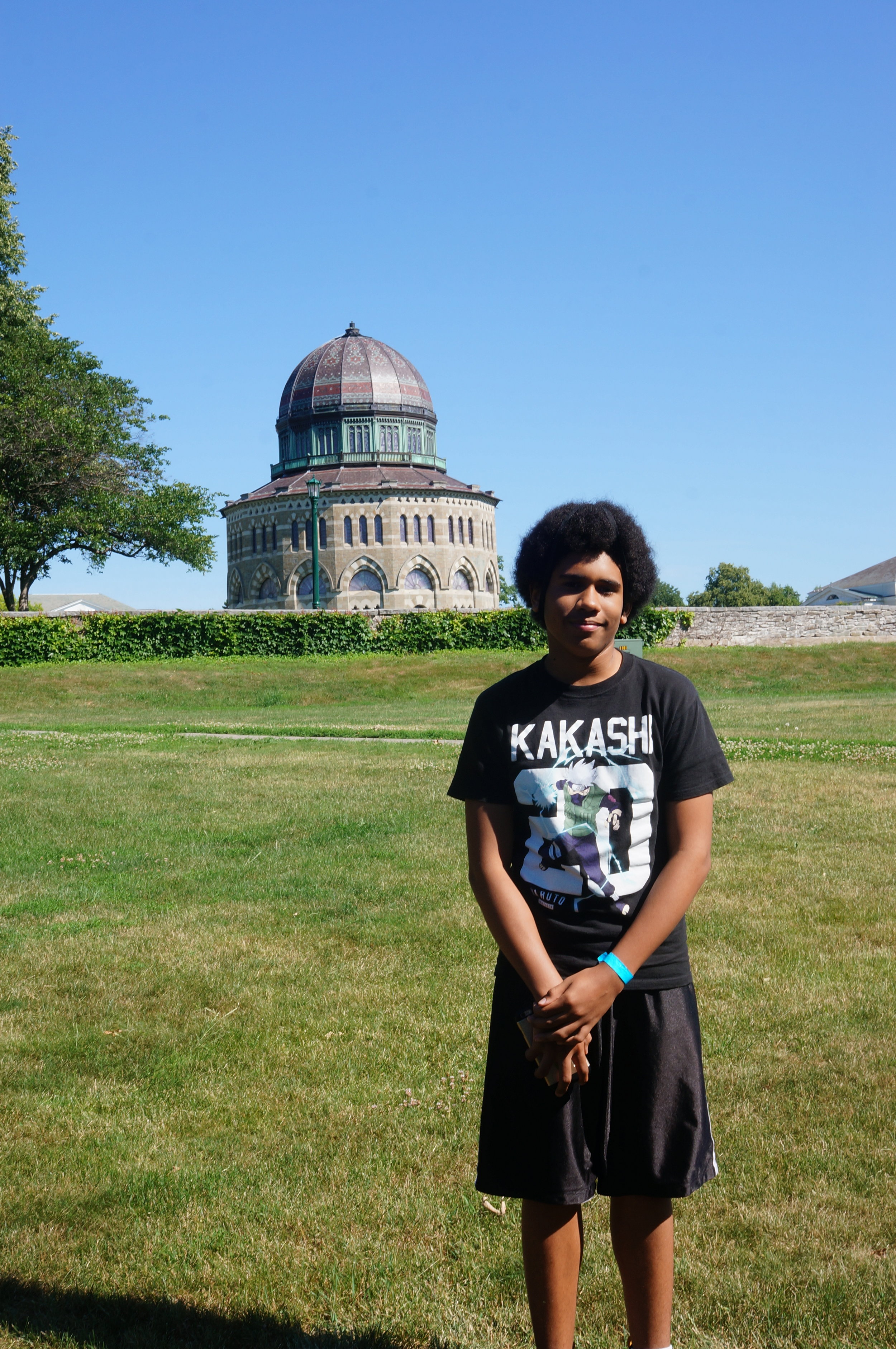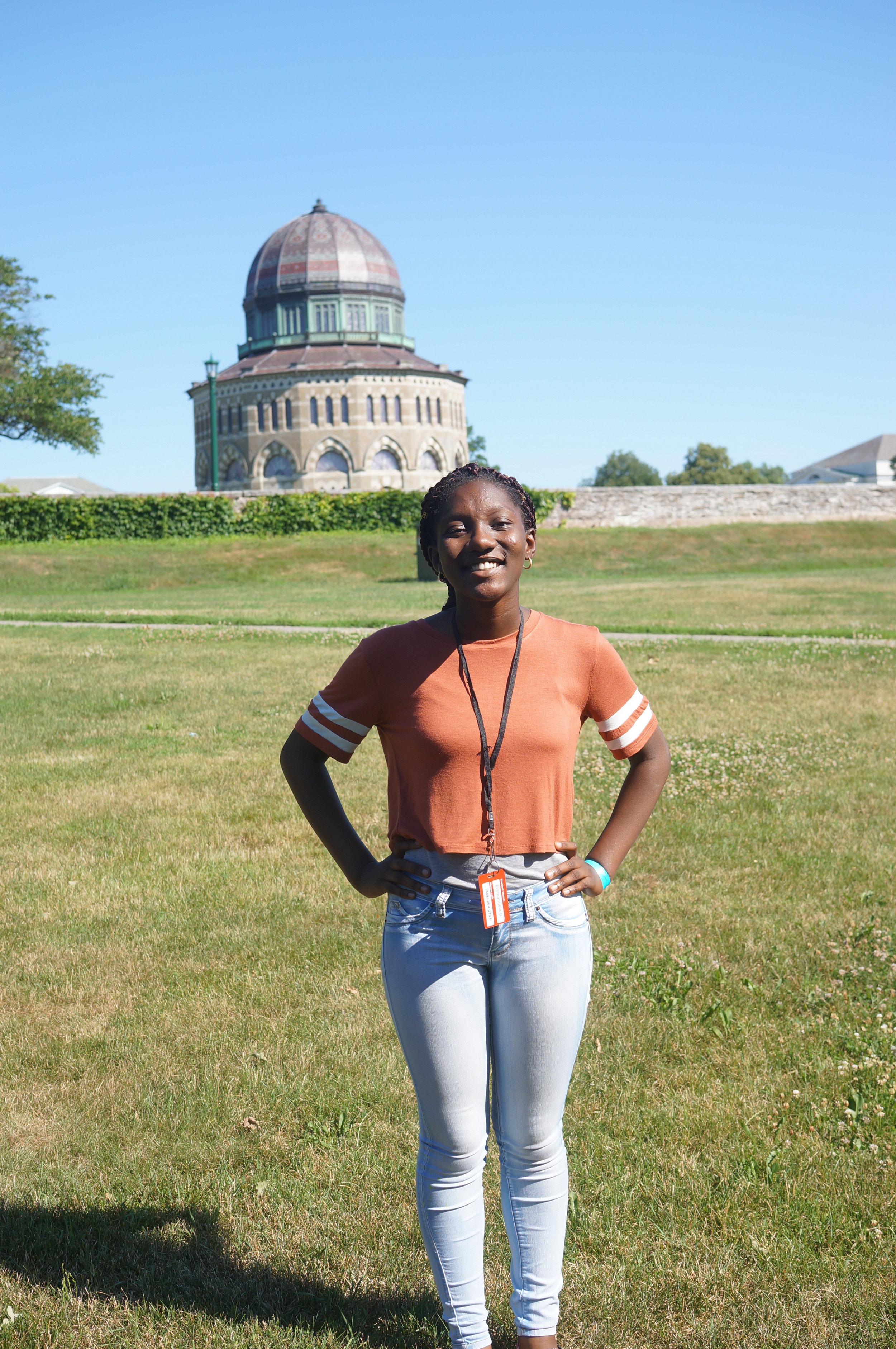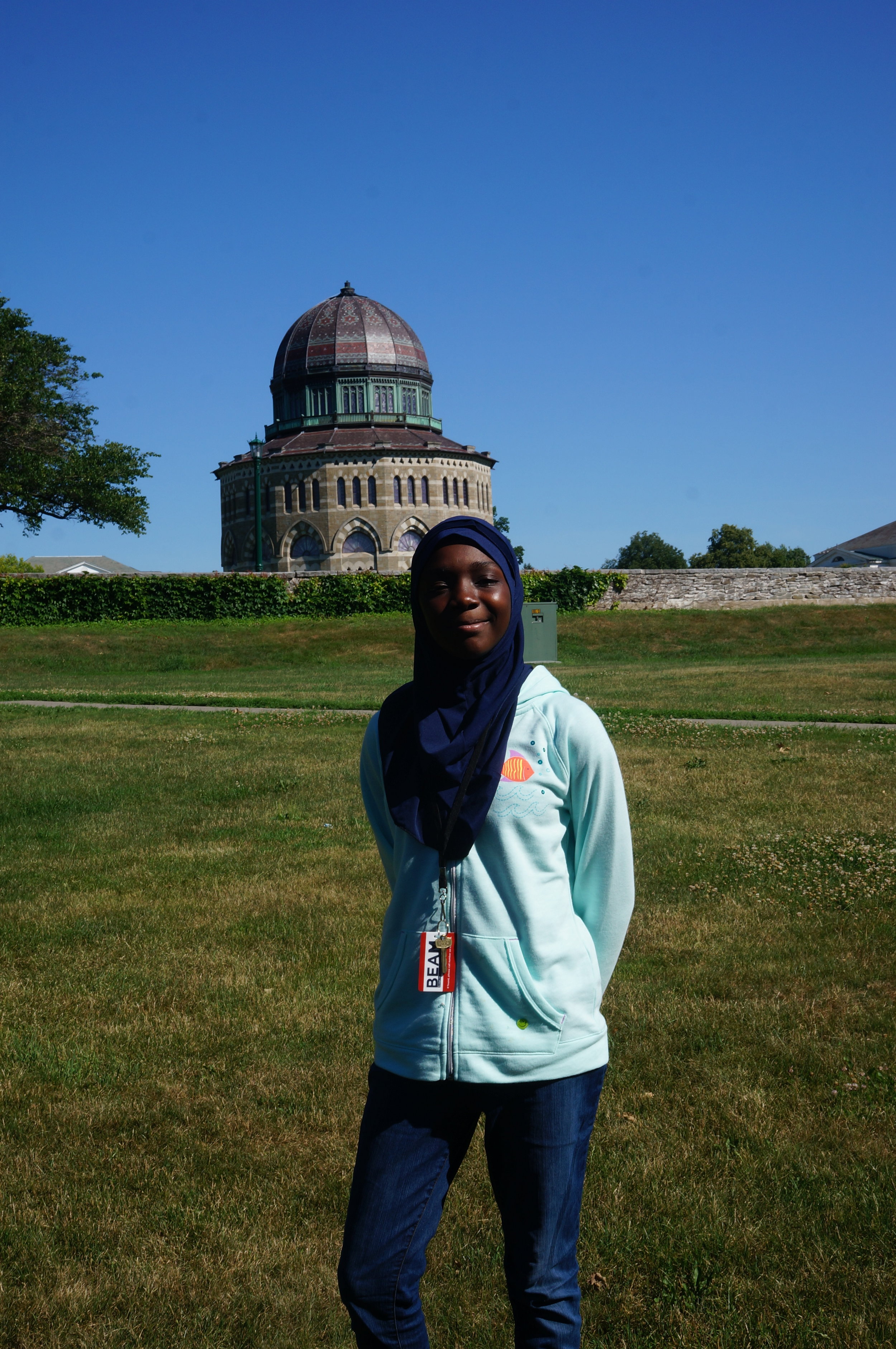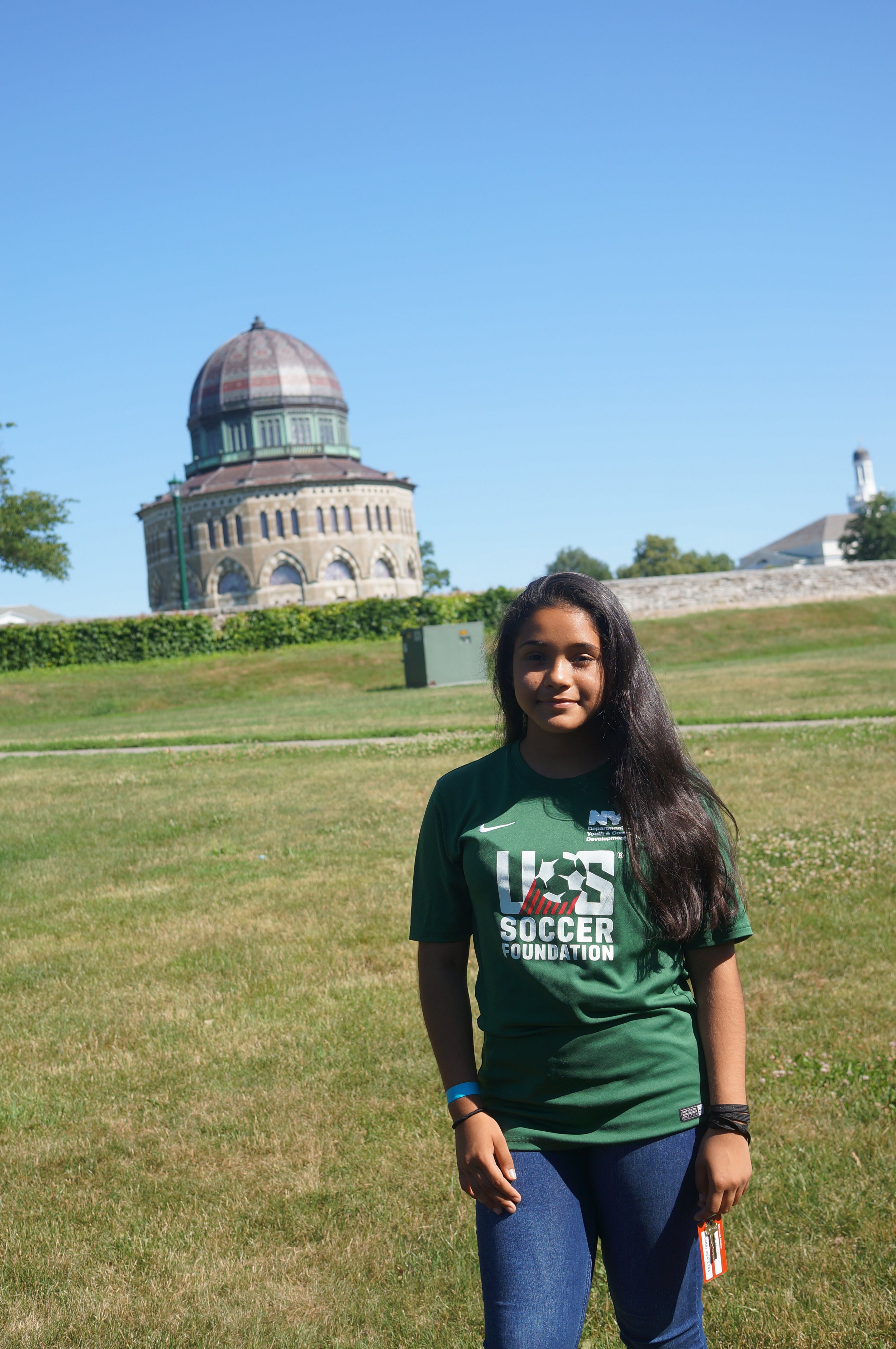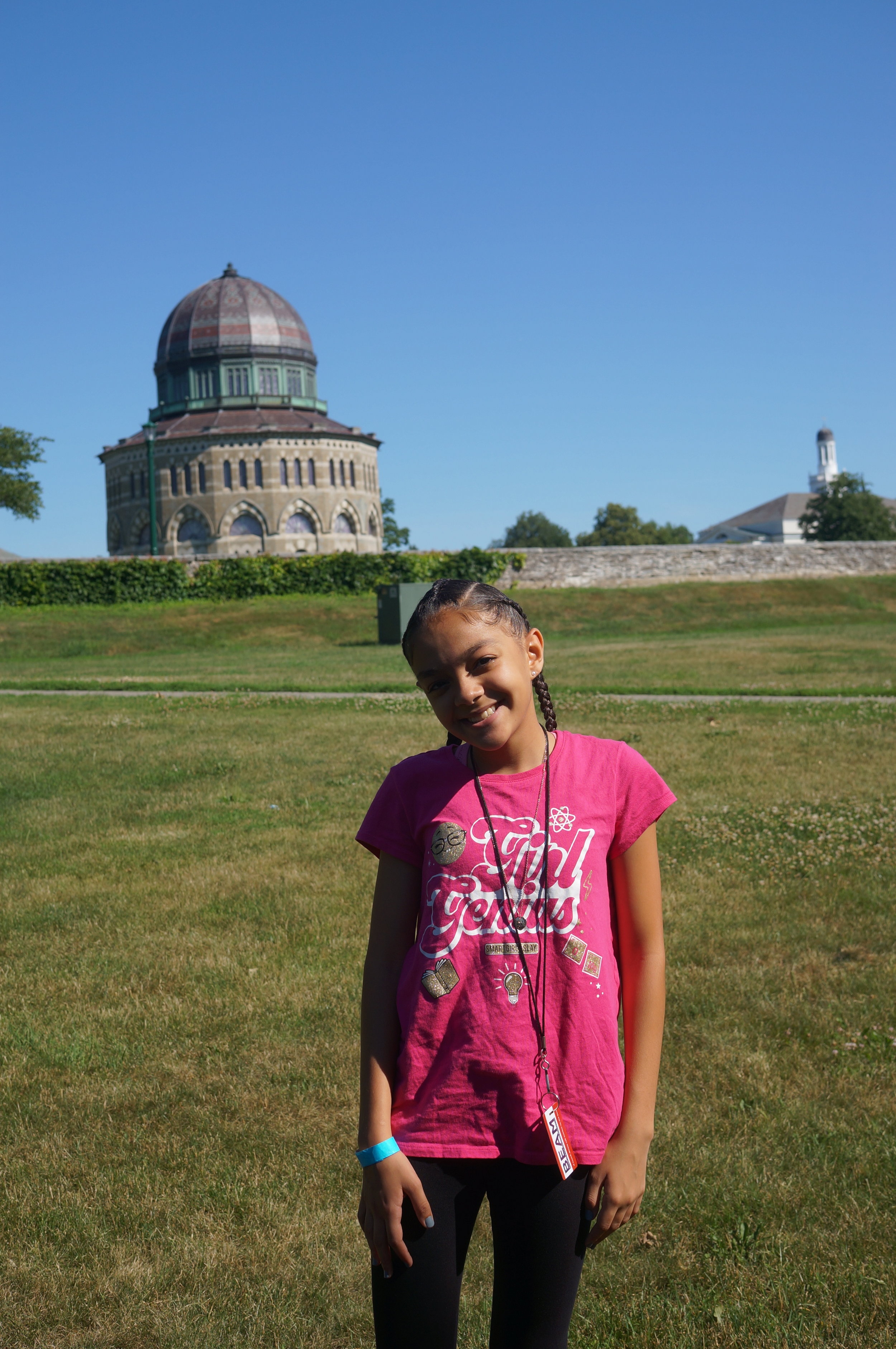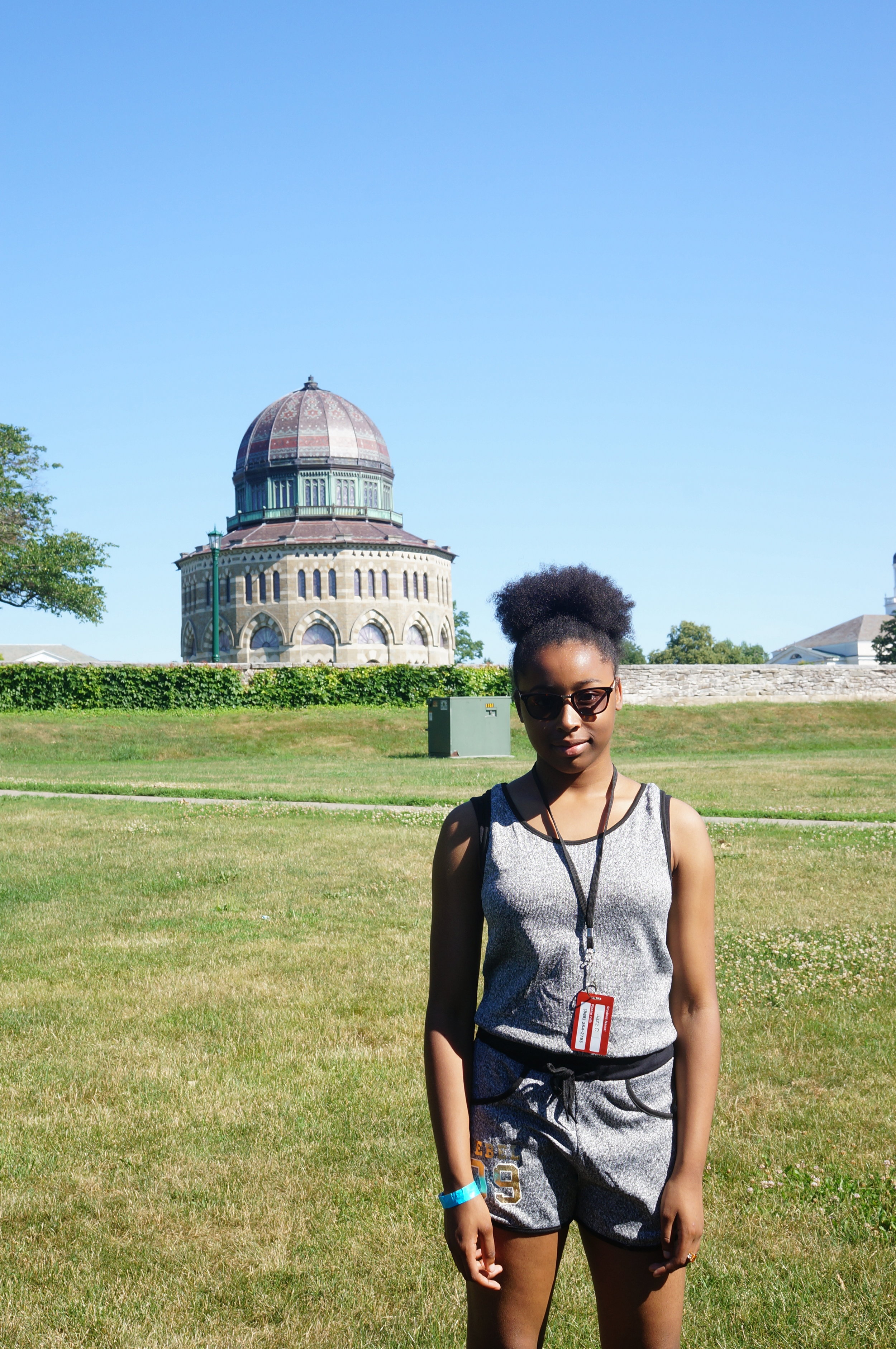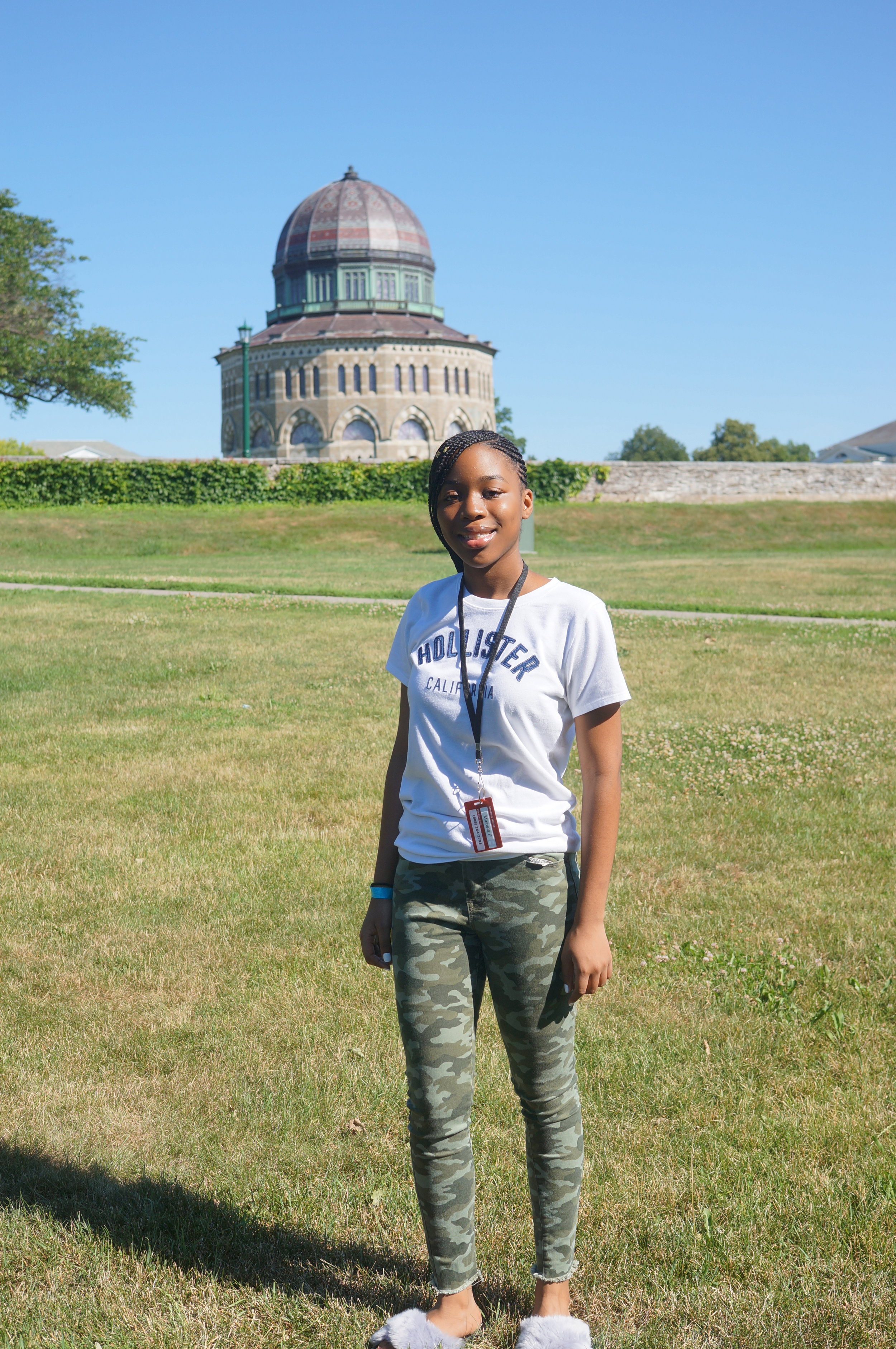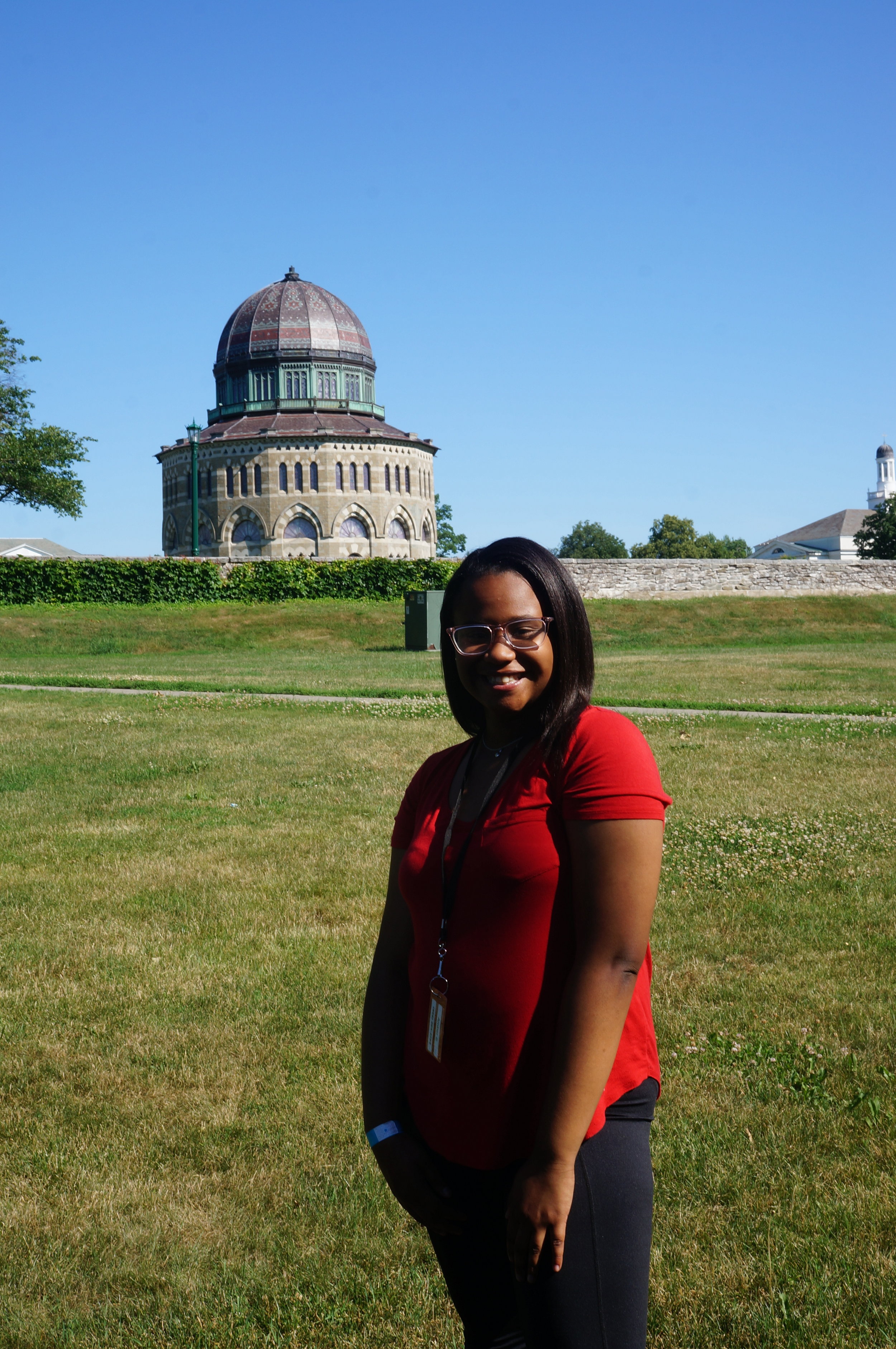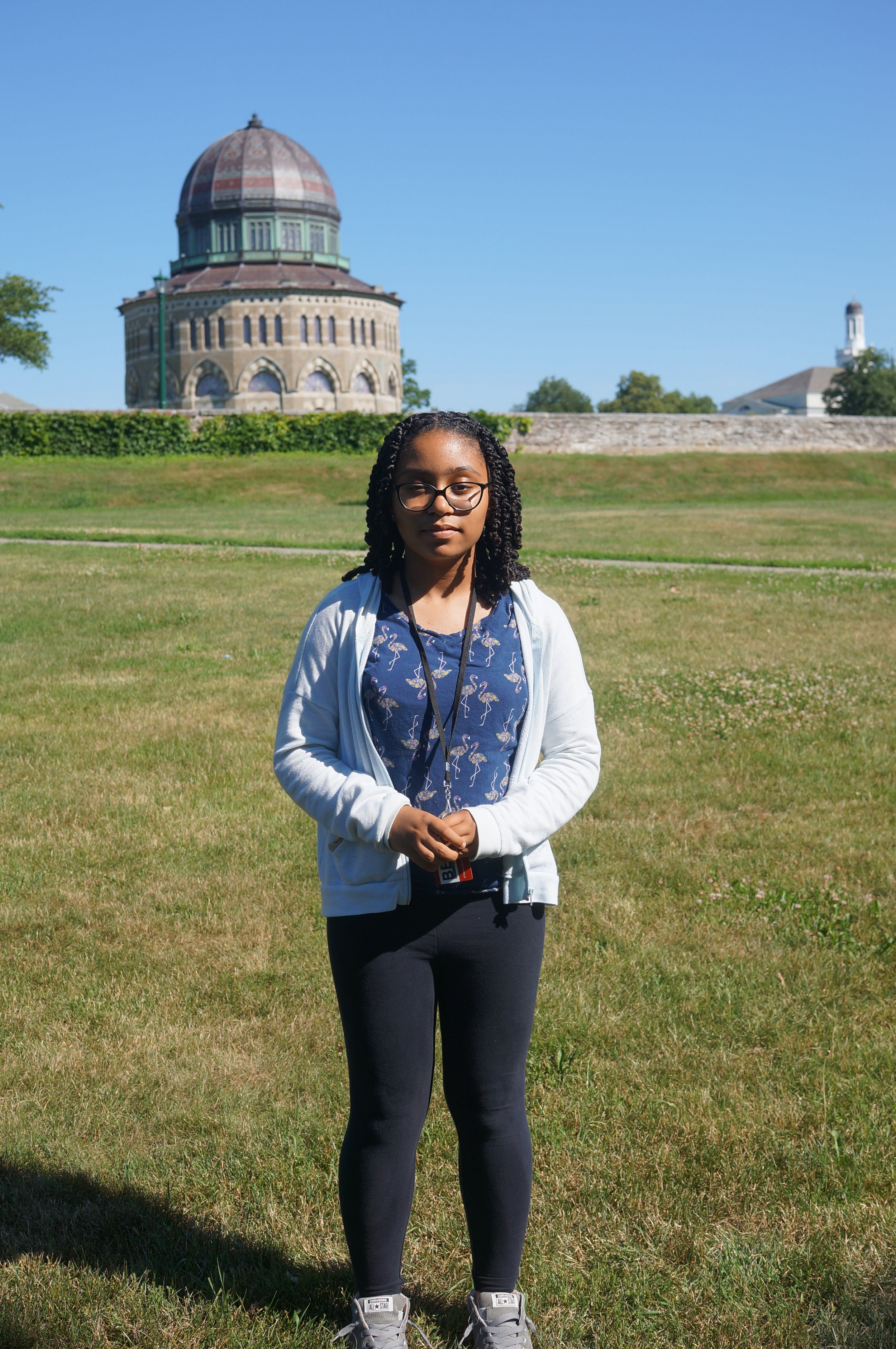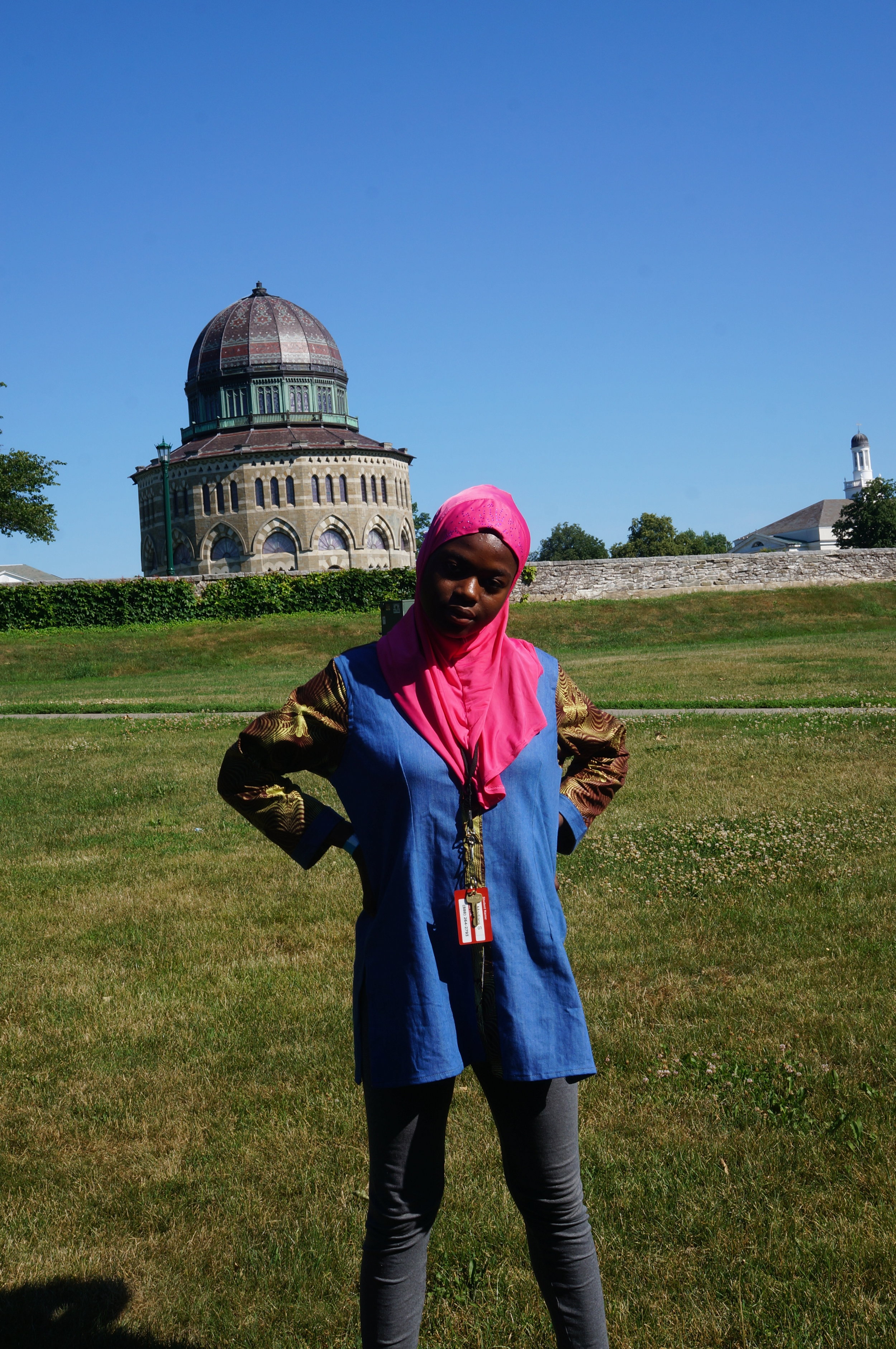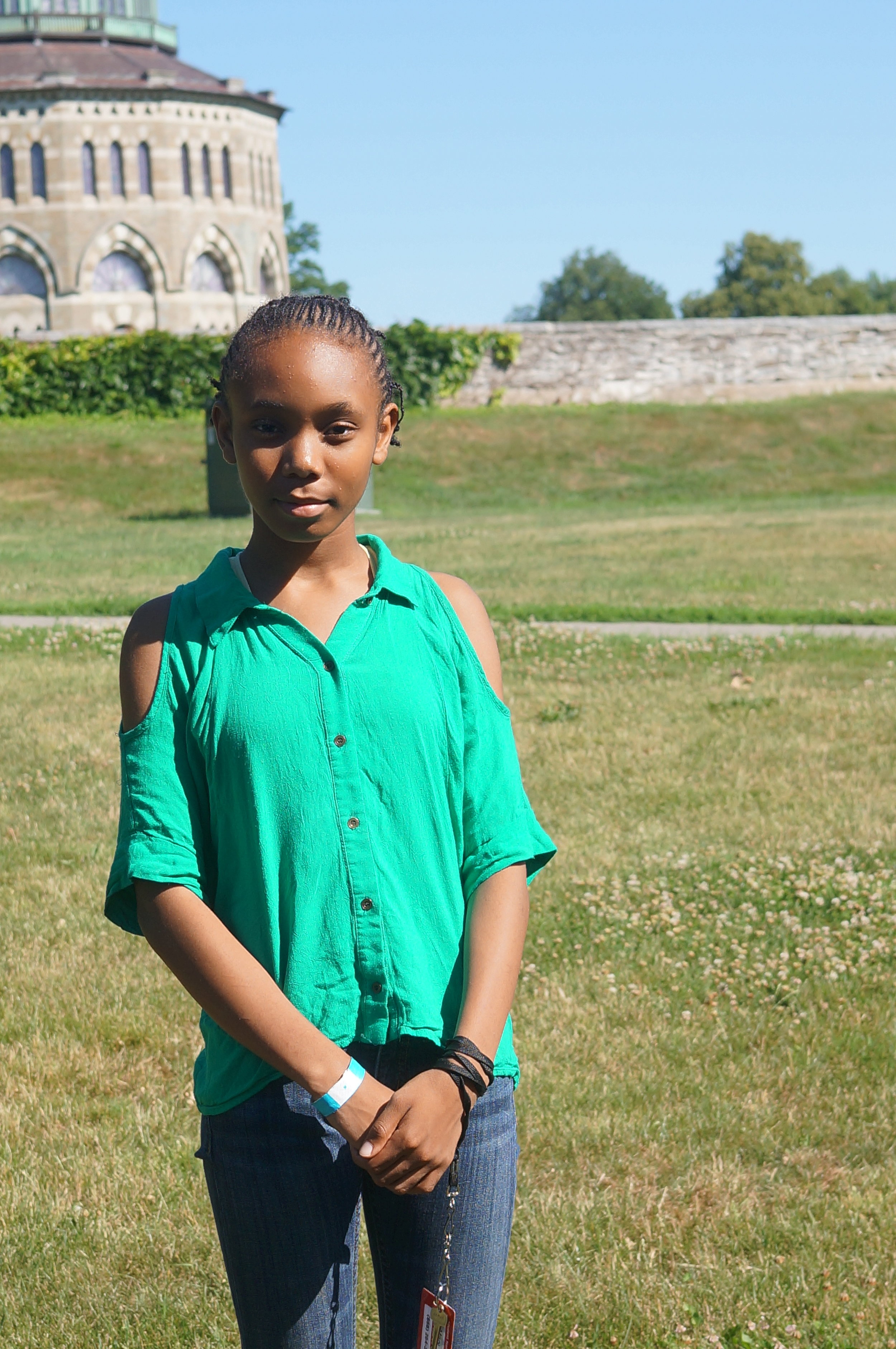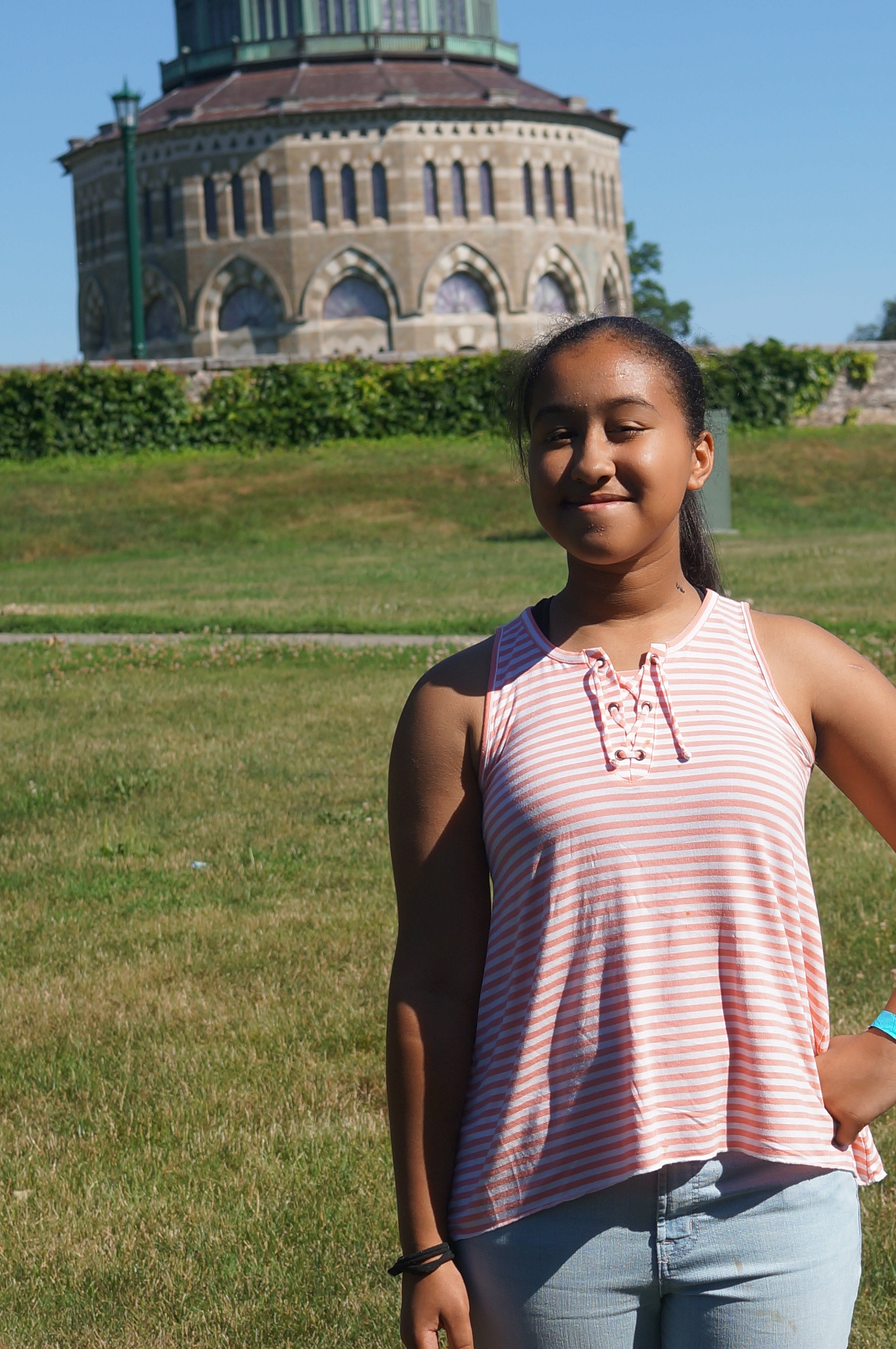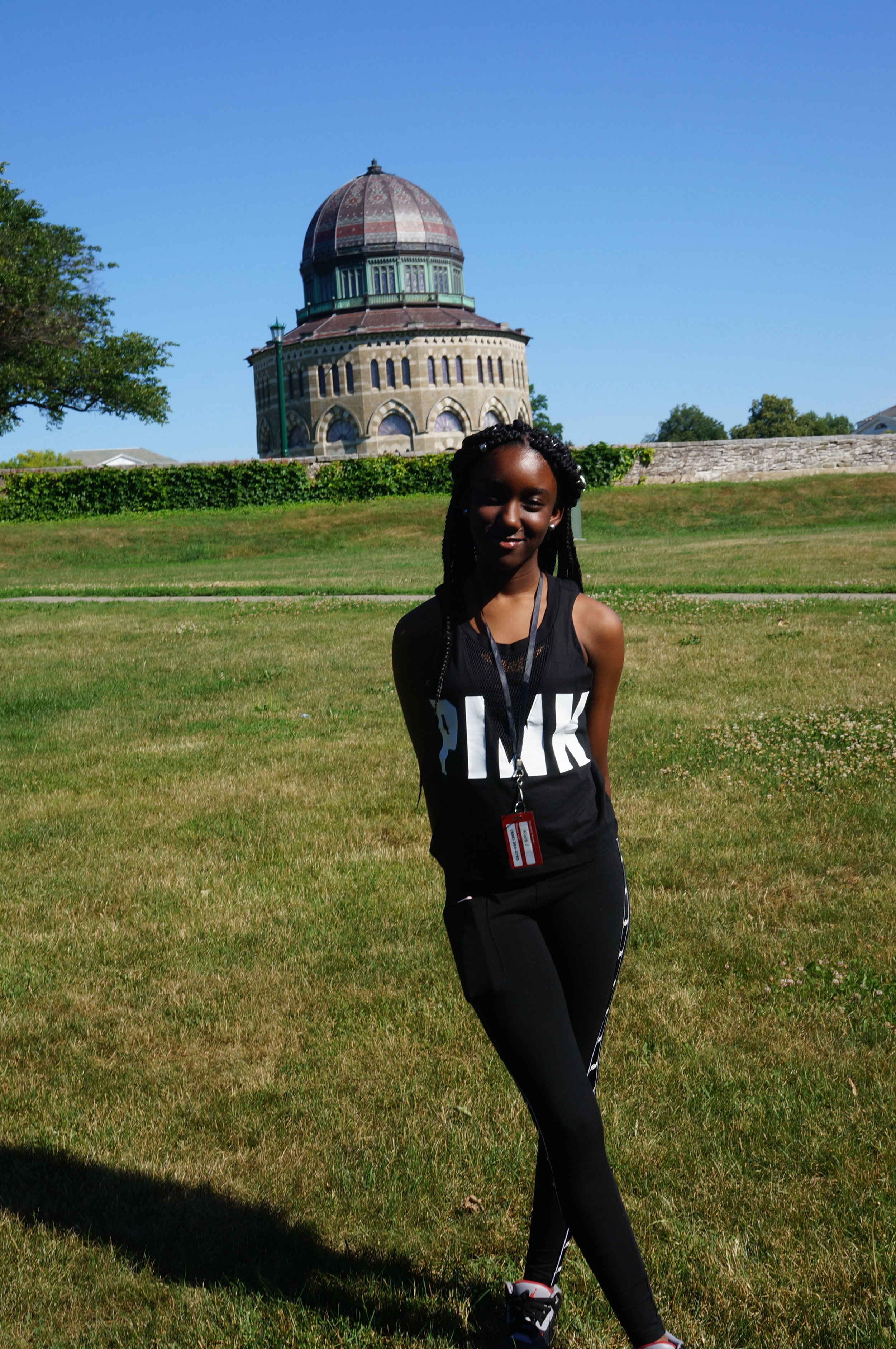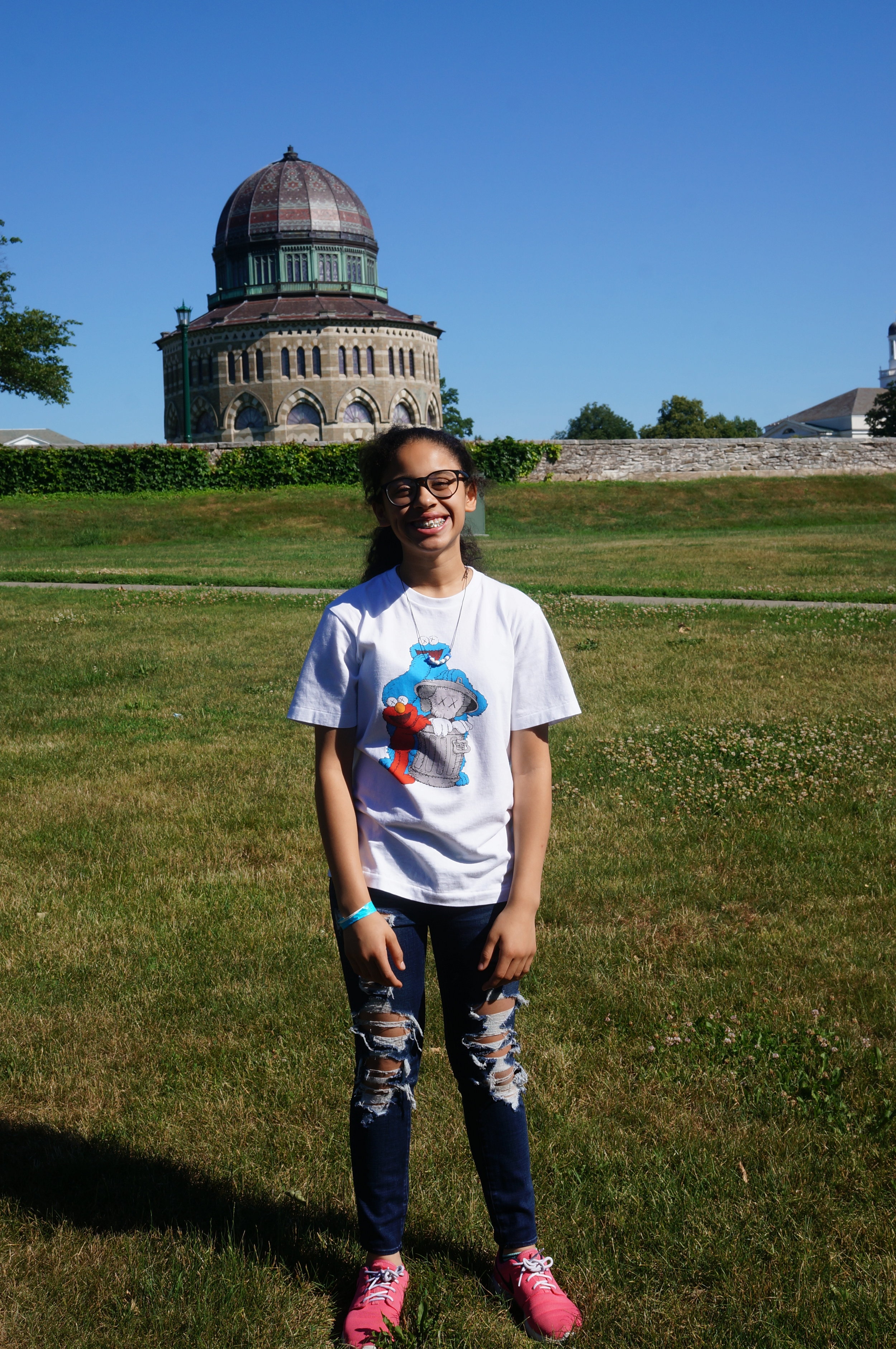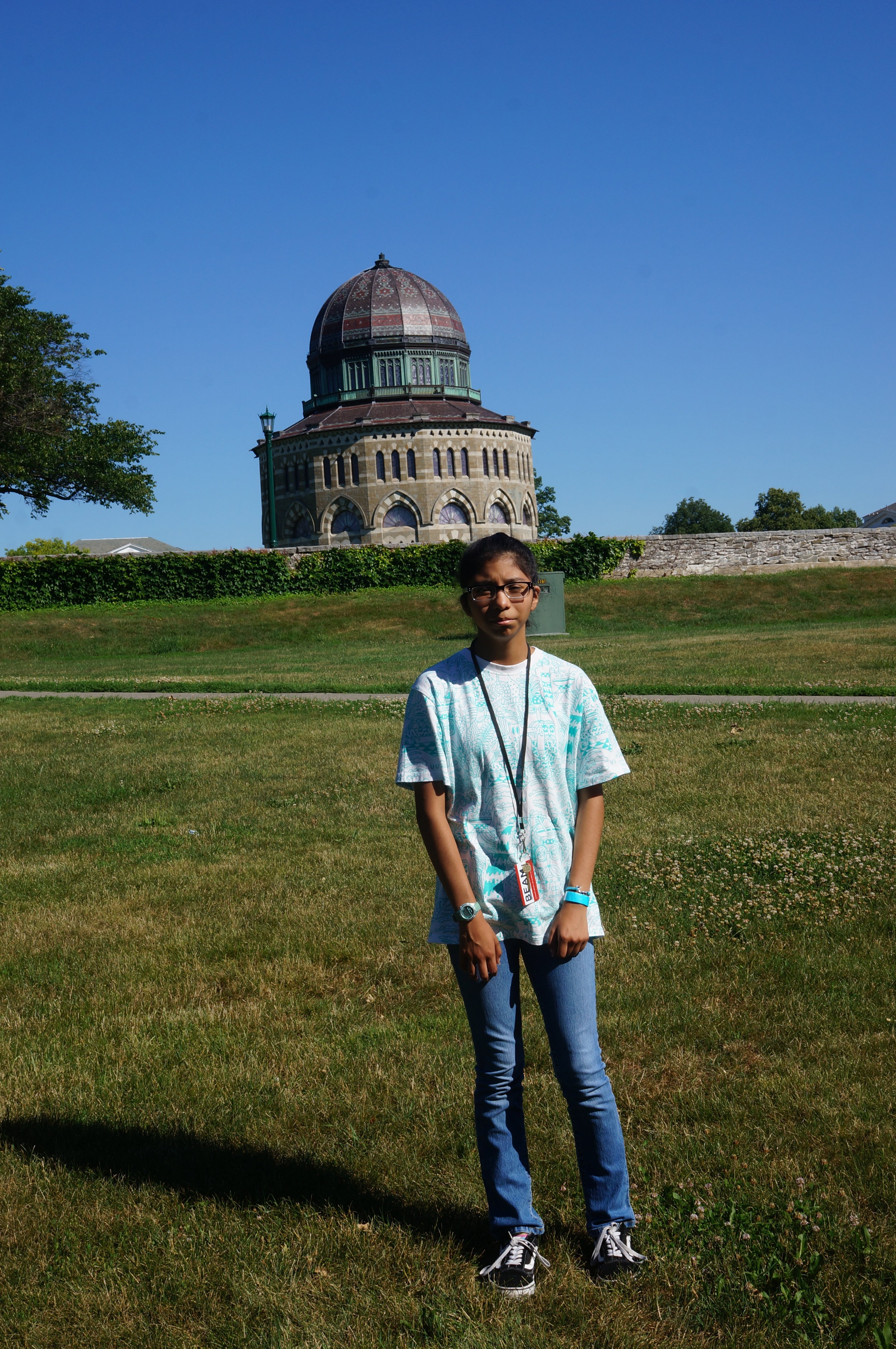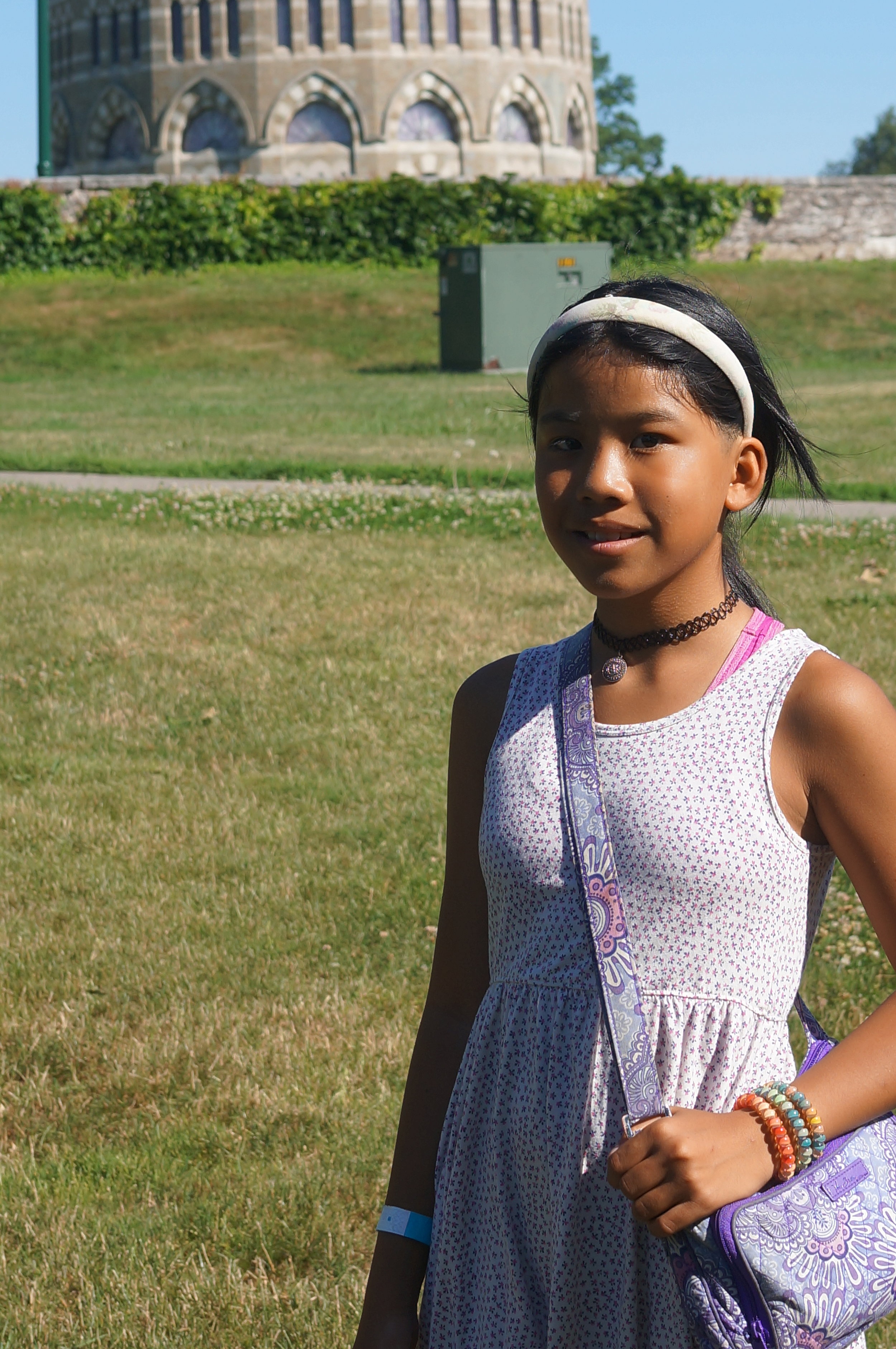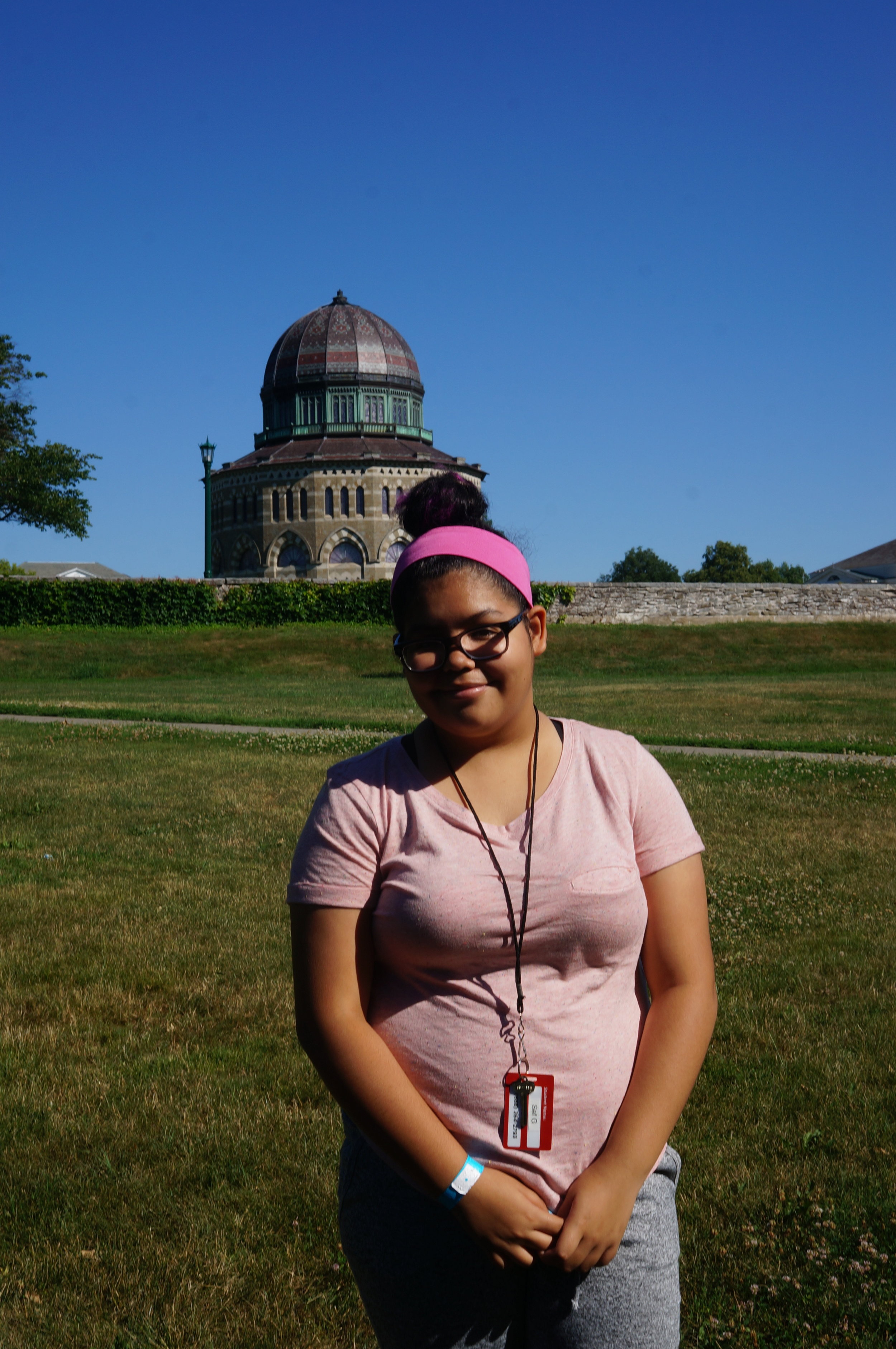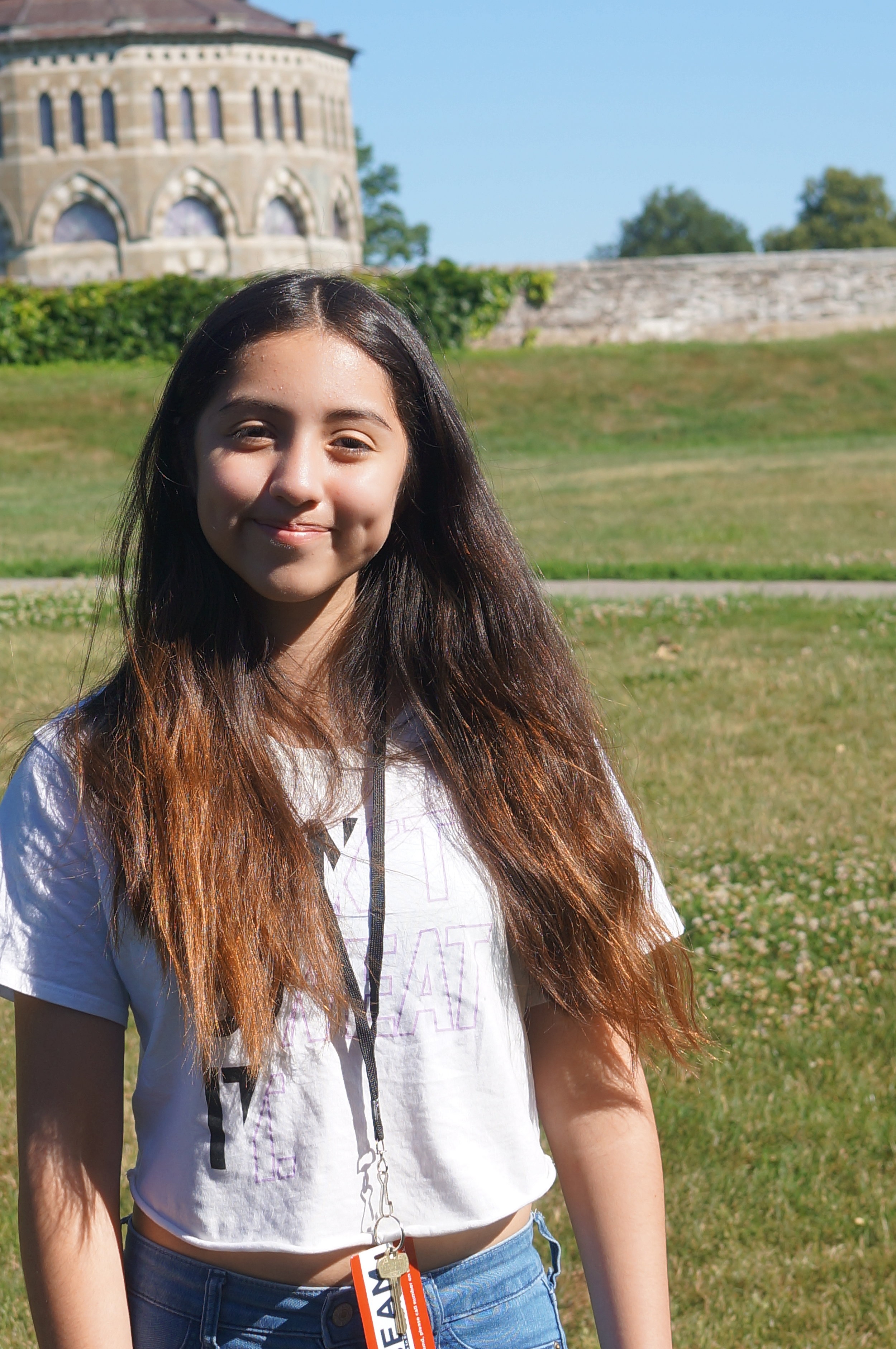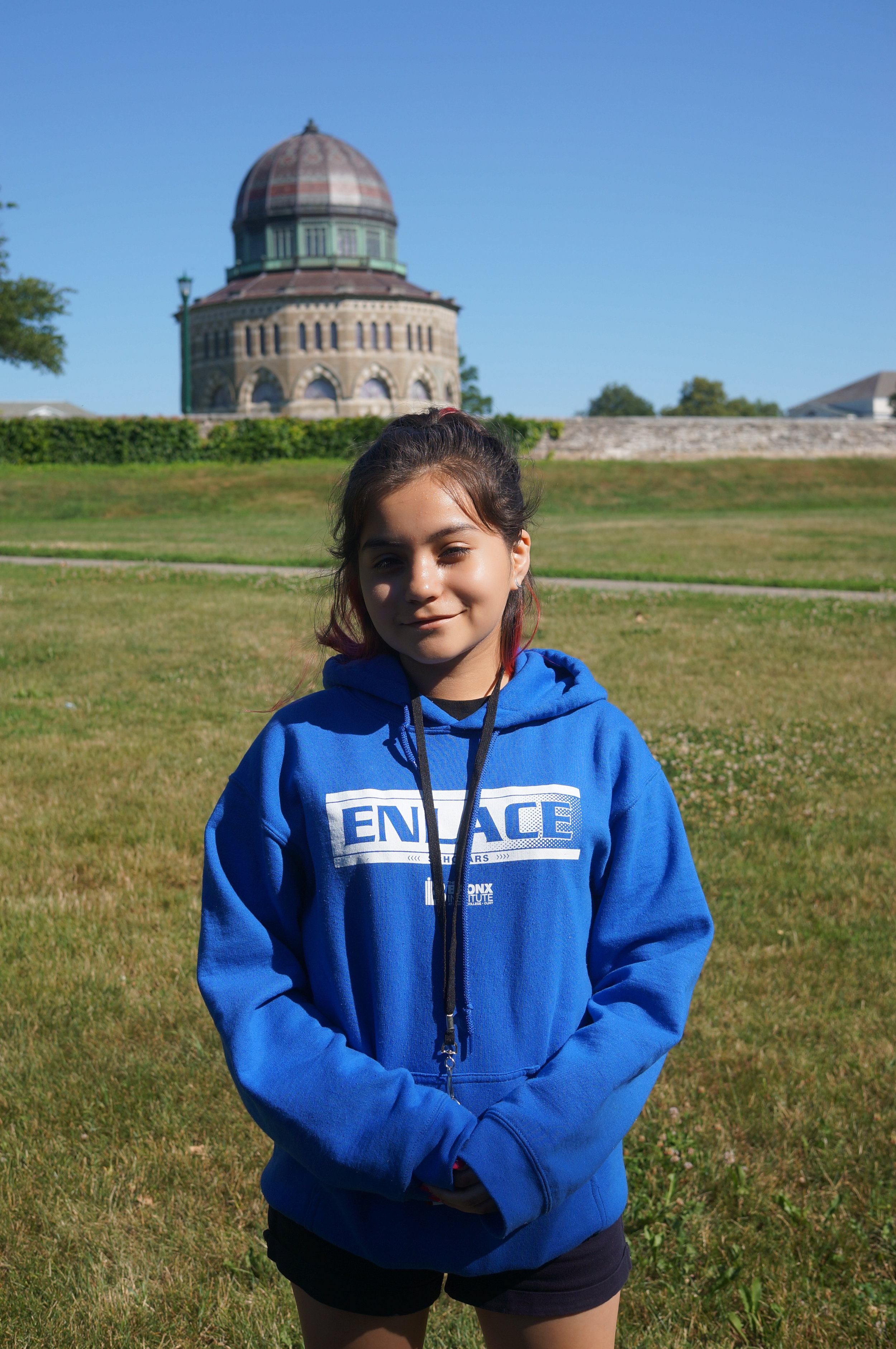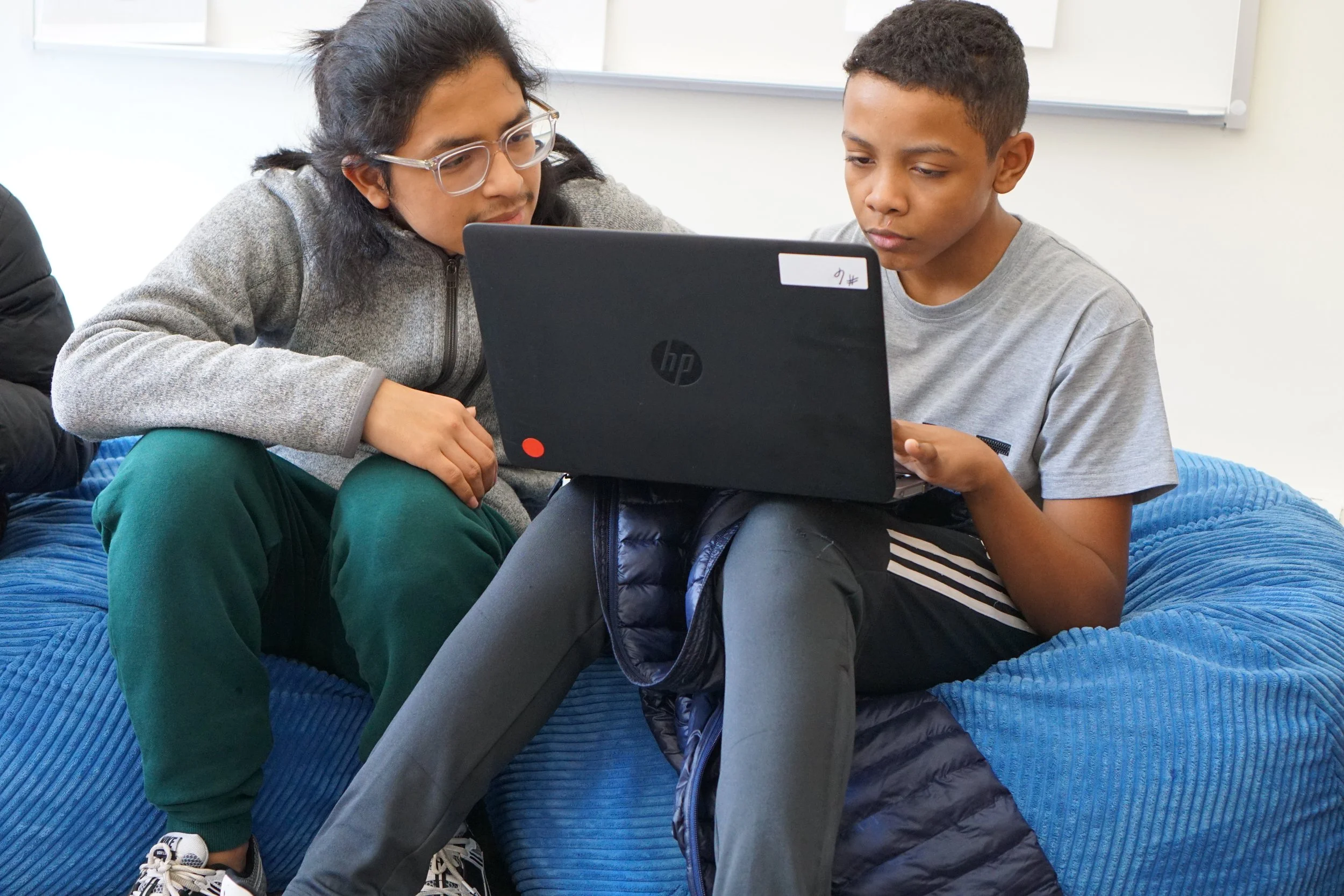
Welcome to the BEAM Blog!
Aisha's Off to Northwestern!
BEAM 7 back in 2013; Aisha is standing in a pink t-shirt about one-third of the way from the left.
Five years ago, 39 seventh graders had just completed their first summer at BEAM. For some of them, it was their first time out of the city, or their first time away from their family. All of them were going to spend three weeks now living away from home and learning advanced math.
This summer, those same students graduated high school (including three with an Associate's Degree) and are just now starting college. Meanwhile, 370 students completed their own first summer at BEAM. It’s a time for looking backward and looking forward, so we asked one of our rising college goers, Aisha, to reflect on the last five years, from the start of BEAM 7 to her journey to college this fall.
Aisha and Shikya learn to solder, July 2013
In spring 2013, Aisha decided to attend BEAM because she really loved math, especially geometry puzzles. The program also promised a chance to get away from home, make new friends, and have fun. She figured she would learn some new skills, but other than that she wasn’t sure what to expect.
At BEAM, Aisha took courses on Proofs, Circuit Design, Statistics, and Math Team Strategies. Her instructor in Math Team Strategies described her as “intent on understanding and solving problems.” She loved the math, which she found to be different and more challenging than what she saw in school, but it wasn’t just the math that altered her trajectory. When asked how she had changed during the summer, she wrote, “I have changed because now I don’t give up. I used to give up a lot, so for me to keep going even when I get frustrated is different.”
We asked all our students what BEAM could do to support them after that summer, and Aisha responded: “I would like to stay in contact because I think I might need help and this camp helped me understand a lot of things I was confused with.”
Aisha, June 2018
And stay in touch she did! In 8th grade, we helped her pick a high school, Manhattan Center for Science and Mathematics. In 9th grade, long before BEAM offered such comprehensive support, we encouraged her to apply to a mentoring program, Minds Matter, where she spent her summers and Saturdays for the next three years. In 11th and 12th grade, when her high school guidance counselor didn’t have the time to give her personal attention, Aisha turned to BEAM to be her college adviser. After being admitted to Northwestern University on a full scholarship, she turned to BEAM again to evaluate her financial aid package and get advice on applying for a summer bridge program to work on her writing skills. This summer, she will be working at BEAM 6 as a Junior Counselor, teaching and inspiring the next generation of BEAM students.
We asked Aisha to look back and reflect. Here’s what she wrote:
From the summer of 2013 until now, BEAM has been a constant factor in my life. The staff at BEAM have supported me and been there for me during my achievements as well as during my failures. They have aided me in so many ways, enriching my ability and my personality. They helped me find a high school that best fit me and they presented me with opportunities for next steps, preparing me for college and the professional world.
Most importantly, throughout the entire college process, BEAM has helped me in more ways than I could have imagined. The college process was one of the most difficult and draining times during my high school experience. However, what made it better was BEAM. When I had to change my college list at the last minute or when I was struggling to write essays, or when I cried because things were too expensive and I couldn’t handle the stress, BEAM helped me any way they could. I particularly appreciate the last-minute grant from BEAM’s Last Dollar Fund to cover $132 in SAT score reports that I needed to send in December 2017, just days before my Common Application was due.
I am grateful to be part of BEAM. I know without them I could never have reached the position I am in today. BEAM has done so much for me. I love being part of this BEAM family.
Now we’d like to turn around and share our appreciation with the entire community of BEAM supporters. Over the five years that Aisha has been part of BEAM, we have grown both the number of students we serve and the services we offer. When Aisha started BEAM, we didn’t even have an office; our two staff members each worked from home. Today, we have offices on both coasts. At the time, we had little high school support and no college support. Today, we not only offer college admissions advising to a core group of students, we are also adding advising through college to ensure that students like Aisha will graduate with STEM degrees. Aisha will get support from BEAM on how to choose classes, how to build relationships with professors, how to declare a major, and how to land an internship, along with regular reminders for all the logistics like filing her FAFSA. Already, at our 12th grade graduation party, Aisha sat down to discuss how an undecided student selects courses for her first semester. We feel confident that in four short years, we will be announcing her college graduation and exciting next plans.
Aisha (right) discusses college plans with Ayinde, BEAM's College Support Coordinator.
Thank you to each and every BEAM donor, summer staff members, family member, peer, and cheerleader. Your support of BEAM allows us to turn around and support Aisha in ways both large and small. Aisha says she wouldn’t be here without BEAM; BEAM would not be here without your support.
PS: Where are the other BEAM students headed?
Aisha in Spain, during her 2017 summer program where she interned at a maker space.
Aisha (center) rehearses for the BEAM 7 talent show back in 2013.
Zanahya, a rising 7th grader, learns to solder at BEAM 6 in 2018. Aisha, who learned to solder at BEAM 7 five years earlier was the teaching assistant for this course.
BEAM students announce their college plans at College Decision Day at the Apollo Theater, May 2018.
Back row: Elijah (Howard), Henry (UMass Amherst), Tanasia (Rochester), Ariel (Brandeis)
Front row: Vielka (SUNY ESF), Aishat (Yale), Will (Haverford), Aisha (Northwestern), Malachi (SUNY Binghamton)
Aisha graduates from Manhattan Center School for Science and Mathematics, June 2018.
Aisha, front, second from left, sits on a panel of BEAM staff and alums providing college application advice to rising 11th and 12th graders, August 2018.
A Day in the Life... of Kathy!
This guest post was written by Dan May, a five-time BEAM instructor, who spent a day getting to know Kathy's schedule and thoughts on BEAM!
Kathy on Day 0 in front of Nott.
“I’m working on a problem.” These are the first words out of Kathy’s mouth as she leaves Richmond Hall, the dorm space where 40 BEAM students and 20 BEAM staff live throughout July. A couple of days ago, it was pouring rain on our 8 AM walk to breakfast. A couple of days before that, it was already sweltering by then. But today the morning is perfect as we walk past the majestic Nott Memorial on the spacious campus at Union College.
“The problem is about finding a strategy for how many floors up you can drop a spy device before it will break,” Kathy explains. (Here's a recent TedEd video on the same problem!) In the next breath, she worries about her roommate, Nikelisi, who has overslept just a little this morning. BEAM students tend to look out for each other, especially by the second week, and Kathy doesn’t want Nikelisi to be late for class. “The fan in our room helps us sleep – maybe it helped Nikelisi too much!”
Cassie and Kathy later, on Field Day!
As we enter the dining hall, Kathy mentions that she is excited to tie dye her t-shirt later this evening for her field day team, but our attention quickly turns to the many breakfast options available this morning: eggs, bacon, pancakes, oatmeal, cereals, yogurt, fruit – the list goes on. Kathy enjoys the food at Union, but like many BEAM students, she misses her family’s home cooking.
While we’re taking our seats, a staff member trips and spills coffee and juice onto the table, floor, and himself. Nearby students and adults quickly pitch in to help clean up, and the conversation turns to embarrassment. Kathy mentions that the supportive environment of BEAM makes people feel much less embarrassed about awkward situations than they might in a normal school. “BEAM is like a democratic society,” Kathy says, going on to describe how everyone’s preferences are taken into consideration when making decisions. This is true: Kathy, like all BEAM students, had a voice in choosing the classes and activities that will shape her day, and summer, at BEAM.
By 8:20 Nikelisi shows up to breakfast, completely nonplussed by Kathy’s joking around that she’s late. (Official BEAM policy: 8:20 is most definitely not late to breakfast.) “What’s your favorite weird math thing?” Kathy asks the table. Claire, a first-time BEAM instructor, mentions the number 0.999…... (that’s zero, then a decimal point followed by an infinite string of 9’s). The ensuing discussion is mathematically rich, as several adolescent women debate whether .999….. is equal to one or not. “The numbers .999….. and one must be different,” Jazz insists. “By how much?” Mikaela replies immediately. It’s exactly the right question to ask, and leads to much more debate, but the issue is not resolved during this breakfast.
Eventually the conversation turns back to the challenge problem, and after Kathy decides that her most recent strategy won’t work she throws up her hands and says “I’m done .....” and then after a beat “ ... I’ll continue.” This kind of persistence is common at BEAM.
Kathy’s first class this morning is Analytic Number Theory, taught by Cory, a veteran BEAM instructor who is an assistant professor of mathematics at Washington and Lee University. Cory deserves his title of Dr. but at BEAM we all go by our first names. Kathy likes this arrangement and feels that it helps her create better bonds with her BEAM instructors.
Kathy shares an idea with instructor Cory and her group, Madjara, Sam, and Jack, during Analytic Number Theory
The environment of Analytic Number Theory is intentionally collegiate – Cory trusts his students. They are trusted to choose their own groups to work in. They are trusted to understand complicated mathematical ideas that are not watered down. Cory believes that mathematicians begin to use mathematical concepts before they are completely comfortable with formal definitions, and the students in his class this morning are correctly using fundamental calculus concepts like limits, and convergence and divergence before they know precisely what these terms mean.
Kathy’s group is working on the sequence generated by the function on the right, and trying to determine if there is a number that this sequence seems to be getting closer and closer to. They discuss the problem with their class’s teaching assistant Bobae, a rising sophomore at Harvard. It’s clear the students have already absorbed function notation, and they are discussing with her how different choices of domain might affect their answer. Someone prematurely declares that they’re “done” with the problem, to which Kathy replies “you’re not done if you don’t understand it!” Everyone agrees with this, and they continue on with their work.
Once they’ve decide to expand the domain past {1, 2, 3, 4, 5} into the set of positive integers, Kathy claims that the answer should be 0. Her reasoning? “The denominator increases while the numerator stays the same, so the answer gets smaller and smaller. Zero is nothing, but this function always gives a fraction of something. The space between the numbers is getting smaller and smaller. So they get close to zero but never get there.” Her group mostly agrees with this assessment – perhaps they remember a similar line of reasoning they saw in a problem in Modules, a quiet, late-night mathematics activity.
After the two-hour block of Analytic Number Theory with Cory, it’s time for the first of two scheduled activities. Today Kathy is playing board games in the Union Student Center. Underneath a high, vaulted ceiling of skylights, students spread out across several tables in a large and inviting space, illuminated with late-morning natural light. This year, students’ favorite board games have included Monopoly and Life, but today we’re learning some lesser-known games. Soon lively matches of Tsuro, Blokus and Niya are underway. And Coup. Coup is a card game in which players assume various personas, including the Duke, Assassin, Captain, Ambassador, and Contessa. By carefully deploying these characters’ skills, players can outmatch their opponents. Or you can just lie a lot. At any point in the game, any player may be bluffing about their true persona. So the game rewards strategy, but also deception, and matches usually become very animated. On this occasion, Kathy attempts to wield the powers of the Contessa – a dangerous gambit that doesn’t end well for her when her bluff is called and Kathy is eliminated from the match.
Kathy plays Coup with staff Don, Claire, and Ayinde as well as students Jade and Andrew
But everyone has fun, and now it’s time to head upstairs in the Student Center for lunch. Kathy’s run of bad luck continues: the current challenge problem has been cancelled. This is a rare occurrence at BEAM, but when the community of students obtain information on a challenge problem in an unauthorized way – well, it’s time for a new problem! Kathy takes this unfortunate piece of news with her characteristic good humor. She even takes an electronics warning in stride. Kathy is an avid music fan, with tastes that run towards songs addressing weighty social topics, and she has been sharing her headphones with a fellow student over lunch. But BEAM has a strict no-electronics policy from 9 AM to 7 PM every day – we’re all here to grow and we believe an essential aspect of that is to be present with each other instead of our devices.
None of this dampens Kathy’s enthusiasm for heading back to Analytic Number Theory for two more hours directly after lunch. During this class period, Cory introduces the class to some very formal and very essential calculus notation:
They spend careful time picking apart each piece of that mathematical sentence. What does “lim” mean? The right-pointing arrow? The students mostly have seen the infinity symbol before, but the use of the equals sign is especially tricky. Like Kathy had said in the morning class, the elements in the sequence will get close to zero, but they will never get there. So how can anything equal zero, she wonders. These are the kinds of questions any college freshman should be considering closely when they first encounter this idea, but frequently they don’t have time to. Eventually, Kathy gets it. “Oh, we’re saying the limit equals zero. Not any terms in the sequence.” This is a breakthrough.
TA Bobae oversees Kathy and her group, Madjara, Sam, and Jack, as they work
Fitz and Zeina play "It's Tuesday!" during an improv activity
Between afternoon blocks of class, students have another scheduled activity period, and an opportunity to have a snack. Kathy’s afternoon activity today is Improv with Hector, another Counselor/TA who is a recent graduate of Rochester Institute of Technology, starting a PhD program in mathematics at Lehigh University. Kathy is delighted by how silly some folks are while acting out their roles: “How are you going to act out an emoji?!?!?”
The third two-hour block of class in Kathy’s day is a class called Solving Big Problems (SBP), where students ..... solve big problems. These are math problems designed to take two hours (or more!) to solve. Kathy’s instructor is Claire, a seventh-grade teacher in Brooklyn (and the .999….. fan from breakfast). Claire does a thoughtful job of helping the students to focus at the beginning of her class. By now it is 4:15, and these twelve and thirteen year olds have been going non-stop since 8:00 this morning (or earlier), and have already spent four hours of very taxing math time in the classroom. Claire’s experience with students of this age is evident. She asks them to spend a few minutes in silent consideration of a photograph of various sizes of pizza pans; each pan is labelled (in the actual photograph, by the pizzeria) with various geometric and pizza-metric information, and the students are asked to generate questions and observations. The students had come into the room a bit disorderly, but they are definitely now focused and ready to go.
Another student, Brandon, works on the problem of the day
Claire introduces the “big problem” for the day – which is actually a complicated question from the mathematical field of graph theory. A graph can be thought of as a network of connections between pairs of objects, and is depicted by a diagram of points (“vertices”) and lines (“edges”). A graph is considered “graceful” if its vertices can be labeled in such a way that generates a labeling of the edges in which every edge gets a different label. The BEAM students have been asked to determine whether certain types of graphs are graceful. A variant of this question is actually an open problem in mathematics – Claire has her students working on a problem that professional mathematicians don’t completely know the answer to!
Another group wrote this about star graphs: "All star graphs can be gracefully labelled as long as there is a 0 in the middle"
But that doesn’t deter Kathy, and she conjectures within minutes of hearing the problem that all “star” graphs are graceful – you just have to label the “middle” vertex with zero. (To be clear – this is not the open problem, but rather one small case of a larger question.) She’s able to write out her conjecture, and a proof, on the whiteboard with her partner Jade. The hardest part for the pair is to determine which part of what they’ve written is the conjecture and which parts are the proof. BEAM students tend to have A LOT of ideas, and one of the skills we work on in all of our classes is how to organize, edit and communicate these ideas cogently. So what goes in the conjecture, and what goes in the proof? Generally speaking, conjectures should be short, concise and clear – the “what” part of whatever you’re doing. Proofs can be longer, more involved, and they contain the outline of how it all works – the “why” part. After some tricky conversations about language, Kathy and Jade revise what they’re written to reflect these ideas.
The SBP class is loud and lively, with many different groups enthusiastically trading ideas. It’s a nice counterpoint to the methodical and deliberate tone of Kathy’s earlier class, Analytic Number Theory. Near the end of the two hours of SBP, Claire brings the students together as a class and asks them to present their findings to each other. Claire then asks them to give “shout-outs” to their peers. “I want to shout-out Jade” Kathy says, and offers public praise to her partner for working out some of the tricky details about the graceful labelling of a path graph.
By 6:15 classes are over for the day, and we are all ready for dinner. Back at the dining hall, Kathy is still thinking over the graceful graph problem, and comes up with a proof that 0 isn’t the only label that could go in the middle of a star graph to give a graceful labelling. The question of counting precisely how many graceful labellings a star graph has gets a bit trickier, and, unprompted, Kathy brings up Alexandria Ocasio-Cortez. The conversation isn’t political per se, but Kathy does mention that successful people often face harsh criticism. She is glad that BEAM is most certainly not like that. “Students are taught to actually use all their tools,” Kathy says. She is beginning to see that mathematics is not something to be thought about in just one, rigid way. There are many paths to success on a problem.
Earlier in the week, Kathy was spotted re-reading Harry Potter and talking with Kenny, an instructor
After dinner, students have 90 minutes of relatively unstructured free time. There is usually an outdoor sport or activity planned, and many students use this time to shower, do laundry, and just hang out with their friends around the dorms. As it turns out, Kathy’s field day team (the Purple team) is tie-dying shirts tomorrow, so she spends her time playing board games in the student lounge. The lounge is a large common area in the basement, and it’s the only air-conditioned space in the dorms. It’s full of comfy chairs, games, and books – both mathematical books such as The Math Book, and non-mathy books like the Harry Potter series (Kathy has some strong opinions about the plot of Harry Potter). Tonight Kathy is learning a game that is new to her, a two-player strategy game called Niya that some others had learned during today’s morning activity.
Kathy (background) works on the board while her modules group members, Brandon, Amber, and Eli, work at a table
Modules start at 8:25. This is quiet, largely self-paced and mostly individual mathematics time. Unlike the rest of the math at BEAM which is exposes students to very challenging topics they might not otherwise see until college, modules is meant to strengthen students’ foundations in school-type math. They work on meticulously chosen problems covering fractions, decimals, exponents, the distributive property and more – basically all the stuff you’ll need to know to excel at algebra. On this particular evening, Kathy is strengthening her knowledge of fractions and decimals, and learning a nice trick: while you would never want to actually report an answer as something like 1.6/400 (a decimal in a fraction? Yuck!), sometimes allowing for something ugly in an intermediate step is exactly the technique you need to complete the problem, and to understand what you are doing more deeply.
After modules, students attend hall meetings. The forty BEAM students live on single-gender floors, and each of these 20-student floors is further halved into “halls”. Each hall is named after a famous mathematician; Kathy’s is named after Grace Hopper, a pioneer of computer science and a Rear Admiral in the US Navy who was born in New York City. From 9:30 – 10:00, students in Hopper (and all the other halls) meet with each other and the two counselor/TA’s assigned to their hall. For Hopper, that is Bobae and B, who is a rising senior, majoring in math, at St. Edward's University in Texas. They talk about what happened that day, discuss any pressing issues the students on their hall may be having, and outline what the next day will look like. This is where students get to pick their activities for the following day, and Kathy is excited to go to Record Club tomorrow, a social music-listening activity.
Student must be in their rooms by 10:30, and lights-out is at 10:45 – lights-out includes no late-night electronics! This means there is generally a little bit of downtime between hall meetings and bedtime. During this late hour tonight, Kathy is playing a low-key game of Uno with several of her friends in the lounge. Earlier in the day, she had joked that “a mathematician is a mythical being like a unicorn! Because who likes math anymore ... says the person at the math camp.” But now she is reflective. “I go to bed much earlier here than usual. BEAM just tires me out way more than regular school.” It’s a feeling all of us at BEAM are familiar with: exhaustion at the end of a mathematically and personally rewarding day. And we know tomorrow will be the same.
Field Day at BEAM 7 Union
Sunday at Union was all tie dye and teamwork as students gathered for BEAM's annual field day! Students participated in games such as pool noodle floor hockey, relay races, staff/student basketball, and a photo scavenger hunt. This photo scavenger hunt led to some of our favorite photos of the day! Each team (orange, red, blue, purple) had one hour to take as many of the photos as they could!
Here were the challenges:
The oldest painted sculpture on campus. (Hint: don’t add anything to it!)
Take a photo with a Union student. Get and send their NAME and their MAJOR.
The orange team with BEAM staffer and Union graduate, Fred, who majored in engineering.
Find a rabbit. Brownie points for taking a picture with a rabbit.
A very presidential figure on campus, and an alumnus. (Hint: he’s bronze, but not because of a suntan!)
Speaking of presidents, where does the president live? Take a cool shot.
Find the building with rainbow stars in the dome. Take a picture from the outside with your finger on the very top!
Find a flower. Take a close-up.
Dance with a staff member. Take a photo.
Find and take a photo of a Minerva House.
Wow, what a Messa. Take a photo of an iceless rink.
We all love learning outdoors. Where can you can sit around a chalkboard-- outside?!
Splish splash. Where is the only pool on campus? Take a photo of the inside.
Tube of toothpaste.
Quiet time! Take a picture of everyone in your team reading a book.
Thank a Union staff member and take a photo with them (ask politely!)
Someone on your team, do a cartwheel. Take a photo mid-wheel.
Form a human pyramid. Please don’t get hurt in the process.
Find a physical map of Union’s campus and point to your location.
Where’s Union’s main gate? Take a photo next to it.
Ready SET go! Take a photo of everyone’s favorite game!
Find a piece of trash on campus and throw it away. Take a picture.
Everyone drink water! Take a picture.
Compose a haiku. Write it down. Take a picture. Use chalk if you want. Brownie points for BEAM-theme.
The blue team haiku: "BEAM is amazing / Mod is very confusing / But I learned a lot."
Find Lynn. Take a picture with her. Make it funny.
Week Two Surveys
Analytic Number Theory featuring Jack, Anais, Madjara, TA Bobae, Kathy, and Sam
It's already week three at BEAM 7 (where did the time go?!) so we're looking back on some of our survey responses from week two. Here's what students had to say about their classes and BEAM 7 in general:
What was good about Analytic Number Theory?
- I like how I came into class knowing nothing about this topic and coming out of it learning so much.
- The calculus.
Zeina and Rose code together in Arduino.
What was good about Arduino?
- That it was challenging but I was able to learn a lot.
- It taught both genders how to love to code: (girls who code) <- not many! (I might be next)
What was good about Cryptography?
Mekhi works on Cryptography with John and TA Fred in the background.
- I really liked the debates the class got into regarding mathematical concepts.
- Everything.
What was good about Infinity?
- I loved how we finally solved our theories and definitions of "infinity." Now I know what it is, and how to use it.
- Everything, for example learning what a number actually is.
Chloe and Emmanuela work with instructor Kenny during Math Team Strategies.
What was good about Math Team Strategies?
- I liked how it helped me explore many math competition problems and it helped me learn alot about interesting strategies to solve them.
- I learned a lot of ways to solve different types of problems very quickly.
What was good about Solving Big Problems?
Alisa and Angie pose with their work after Solving Big Problems.
- I like all the interesting questions thrown our way and how we learned from each one.
- It made us keep questioning everything.
- It made me think in different ways.
Do you have any other comments on BEAM 7?
- This program is awesome!
- It is an awesome program, and I hope that there's a BEAM 8!
- I like this program.
- I love it. I will miss everyone.
- Nope. Thank you. ⭐⭐⭐⭐⭐
- It's awesome; make it longer.
- It's great so far.
- Make Beam 8.
Spotlight on Classes: Analytic Number Theory
Each week, the students are able to list their preferences for which classes they would like to take. They take one course for four hours a day, and another for two hours a day. Each week, new classes are offered and the students have the opportunity to immerse themselves in different advanced mathematical topics.
While each of BEAM’s classes explores incredibly interesting and advanced ideas, we’ve put together a spotlight on just one of the six courses offered this week: Analytic Number Theory with Cory.
The class has just seven students, with a teacher and a teaching assistant—the kids get to really get to know one another and the staff members! In just three days, the class has gone from not knowing what a function is to being able to find the limit as n approaches infinity of f(n) = (-1)n/n: zero. The students are basically doing calculus without using the word “calculus” itself!
Sitting in on the class, what is most impressive to our staff, even more than the sheer speed and intensity of the class, is how engaged each student is. Cory will give short lectures, but for a majority of the class, the students work in small groups in order to work on difficult problem sets. Mostly, they are teaching themselves the topics! Today in class, we were beyond impressed to see how each of the students was able to find patterns and draw conclusions from sequences of numbers.
When Anaís and Cynthia talked about the class, they said that they couldn’t believe how much they were learning in such a short period of time!
Jack agreed, saying: “I’ve learned more math in the past three days than I did in the last two months.”
Cynthia, Jack, Anaís, and Alvin work together on the board
Week two classes are now officially over at BEAM 7 Union College. We can't wait to see how much learning takes place in week three!
Weekend Trips at BEAM 7
BEAM works a little differently in that our academic week is Tuesday-Saturday and our weekend is Sunday and Monday. We do this so that when we go on fun trips, they’re less crowded and kids can really get the most out of their day off!
This past Sunday was our first field trip. We went to Grafton Lakes State Park, where we hiked and hung out at the beach. Most of the camp went for a fun, short hike around the lake and spent several hours at the lake, where they swam, built “sand volcanoes,” played sports, and just hung out with one another. Four of our students—Anais, Brandon, Cynthia, and Emmanuela—went on our hardcore hike. They hiked about 8 miles and climbed a fire tower! Here’s a photo of them with the amazing view they got at the top.
Here are a few photos of all of our students hanging out around the lake:
We came back incredibly exhausted, but excited for the next day: Zoom Flume Water Park!
At Zoom Flume, we spent the day riding crazy slides and rides and enjoying ourselves in the wave pool. Since we were at the park at the same time as BEAM 7’s Bard group, we got to know some of the other students. We don't have many photos from the water park, because we didn't want to get our phones wet!
The weekend was pretty jam-packed, but we’re already back and starting a whole new week of classes!
Our First Week at Bard!
What does it feels like to be a middle school student taking challenging math courses? Ask BEAM students as they have the answers to most of your questions whether mathematical or not.
For the most part, BEAM students have been describing their first week of Math classes as both challenging and fun. As their regular schedule starts at 7:45 AM with a walk to the dining hall, our young adolescents are always reminded of the busy schedule ahead of them.
However, to remain focused in their classes and maximize their performance in some of their favorite activities, our students are learning healthy habits such as correct meal portions, staying hydrated, and good communication skills.
Life at Bard can be described as anything but ordinary. Through daily interactions with their peers, our students are learning how to respect each other's ideas beyond classrooms.
No matter the situation that these thinkers are placed in, their eagerness to ask questions and help each other surpass their current mental and physical state. Their hard work and dedication has indeed marked a successful ending of their first week at Bard College.
A Typical Weekday at BEAM 7
Bobae!
Today, we’re showing you what a typical day at BEAM looks like! With things happening from 8AM to 10PM, we’re pretty busy all day long. This guest post is written by Bobae, a counselor at BEAM, who just finished her first year at Harvard.
8-9am: We begin with breakfast—what better way to get energized for the jam-packed day? The students can leave for breakfast with the counselors between 8:00 and 8:30. We head out to the cafeteria, where the kids get buffet-style options.
9-11am: The kids put their cell phones away until 7pm. (Don’t worry, if there’s an emergency, we will always make an exception!) From 9-11, the kids are in math class with a teacher and a teaching assistant. The classes are designed to let the students figure things out for themselves, and, frequently, the teaching assistants are not told the material ahead of time—so that they learn alongside the students! We like a collaborative and interactive learning environment.
11am-12:15pm: The students and counselors participate in fun activities, ranging from sports to arts and crafts to any other fun activities the kids can come up with. There are eight activities offered every day, but students only have time to participate in two! They can request whichever activities they prefer, and are assigned to their choices each morning.
12:15-1pm: Lunch. It’s a well-deserved and refreshing break from all of the learning!
1-3pm: We’re back in class. We all work together on cool math problems and ideas.
3:05-4:05pm: We have a second activity. The kids take another well-deserved brain break, followed by a ten-minute snack break at 4:05.
4:15-6:15: We’re in our last two-hour chunk of classes: the home stretch! Even though this may seem like a lot of class, the kids still stay incredibly engaged and enthusiastic through the entire day.
6:15-7pm: We eat our last meal: dinner. The main part of the day is finished!
7-8:20pm: After dinner, the kids get free time to socialize, play sports, do laundry, shower, or take naps. One of the most popular evening free time activities is just relaxing in the dorm lounge:
8:25-9:25: We have our last academic activity of the day: modules. Modules are a self-paced, self-motivated way of learning: We study topics that are more relevant to school math classes. Our past students say that modules were incredibly helpful in future math classes.
9:30-10:00: Hall meeting! Each floor meets with its two counselors to discuss the day: how it went, and any announcements for the next day. As a counselor, this is definitely one of my favorite parts of the day; I love getting to see the kids at the end of their day as they reflect on how camp is going.
10:30: Room check. Students must be in their rooms and ready for bed.
10:45: Lights out! We want to make sure the campers get a good night’s sleep before the next day begins.
And now…time to do it all over again!
Icebreakers at BEAM 7 Union!
Day 1: Today was a day full of fun icebreaker activities and rule explanations. For our icebreaker activities, we played a round of human bingo, a team-building game on birthdays (that involved absolutely no speaking at all!), a camp-wide rock-paper-scissors tournament, and a name game where we would all assign adjectives to our names and memorize each other’s names and adjectives. We managed to find descriptors for students across the alphabet, from Adorable Angie to Zebra Zeina and everything in between: Lovely Luixander, Jazzified Jasmine, Magic Mekhi, and Bubbalicious Brandon!
Check out some photos we took during icebreakers!
Move-In Day
Day 0: Welcome to BEAM! Our seventh graders moved into Union College’s Richmond dormitory last Sunday, July 8. The day was jam-packed with fun activities as the kids unpacked and got to know each other.
We first met up with them at Bryant Park. The counselors and staff members took small groups to lunch. We began to get to know the kids as they ate and socialized with each other and us.
Staff at Bryant Park.
After lunch, we boarded the bus to drive up to Schenectady. The ride was long, but many of us talked the whole way back. You could feel the excitement on board!
We arrived on campus around 4:00. We unpacked and toured the dorms and the campus itself. After a nice dinner in the cafeteria, the counselors and kids met to go over a few rules before the kids got ready for bed before their 10:45 lights-out time.
Here are all 40 of our students upon arrival to campus! We're sure this is going to be an amazing summer.




























































